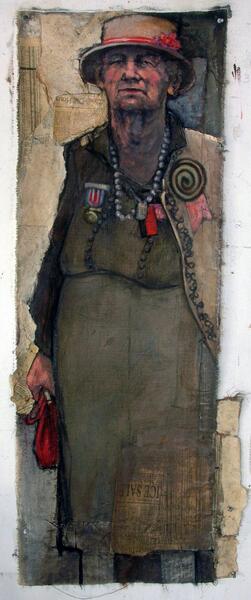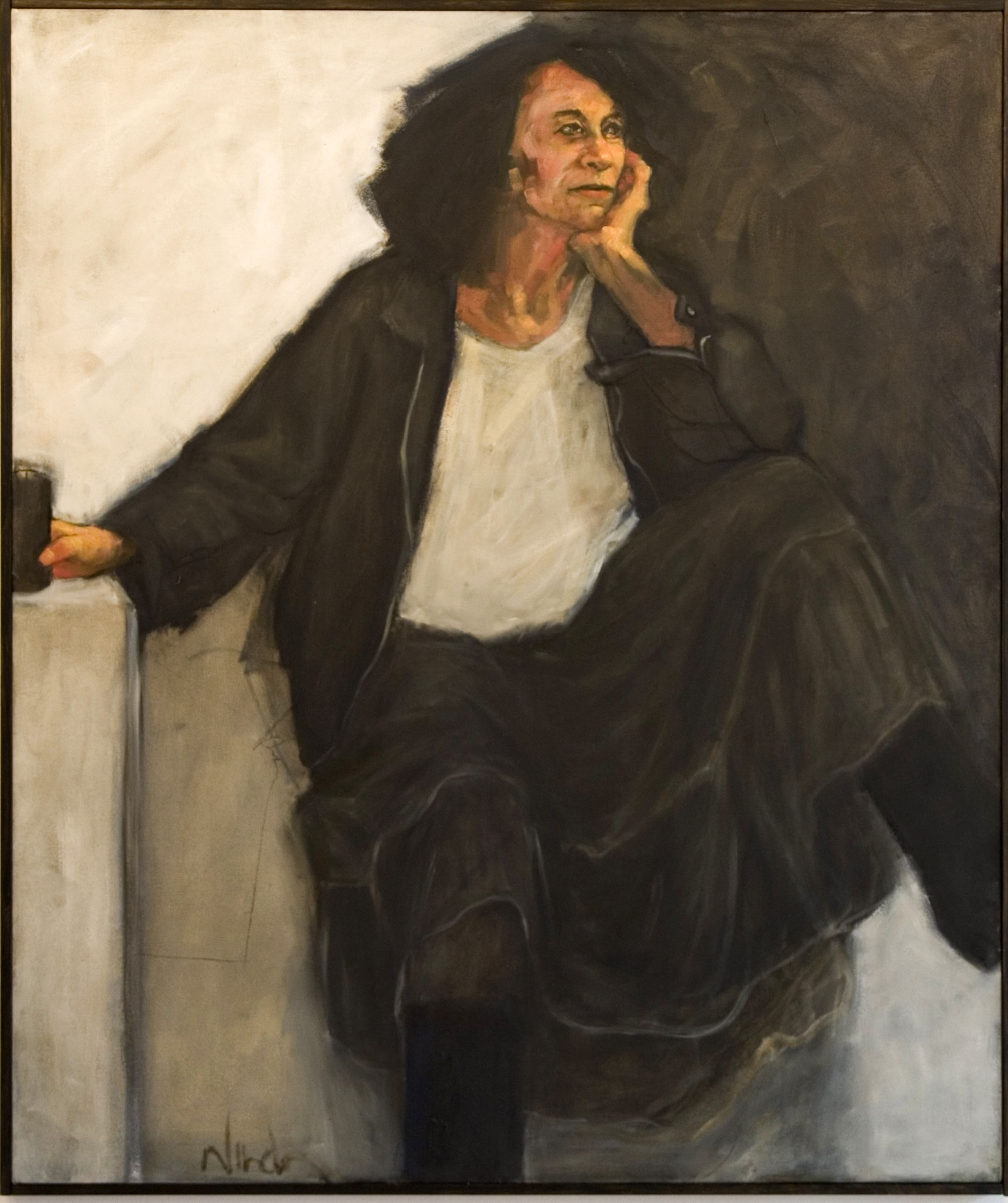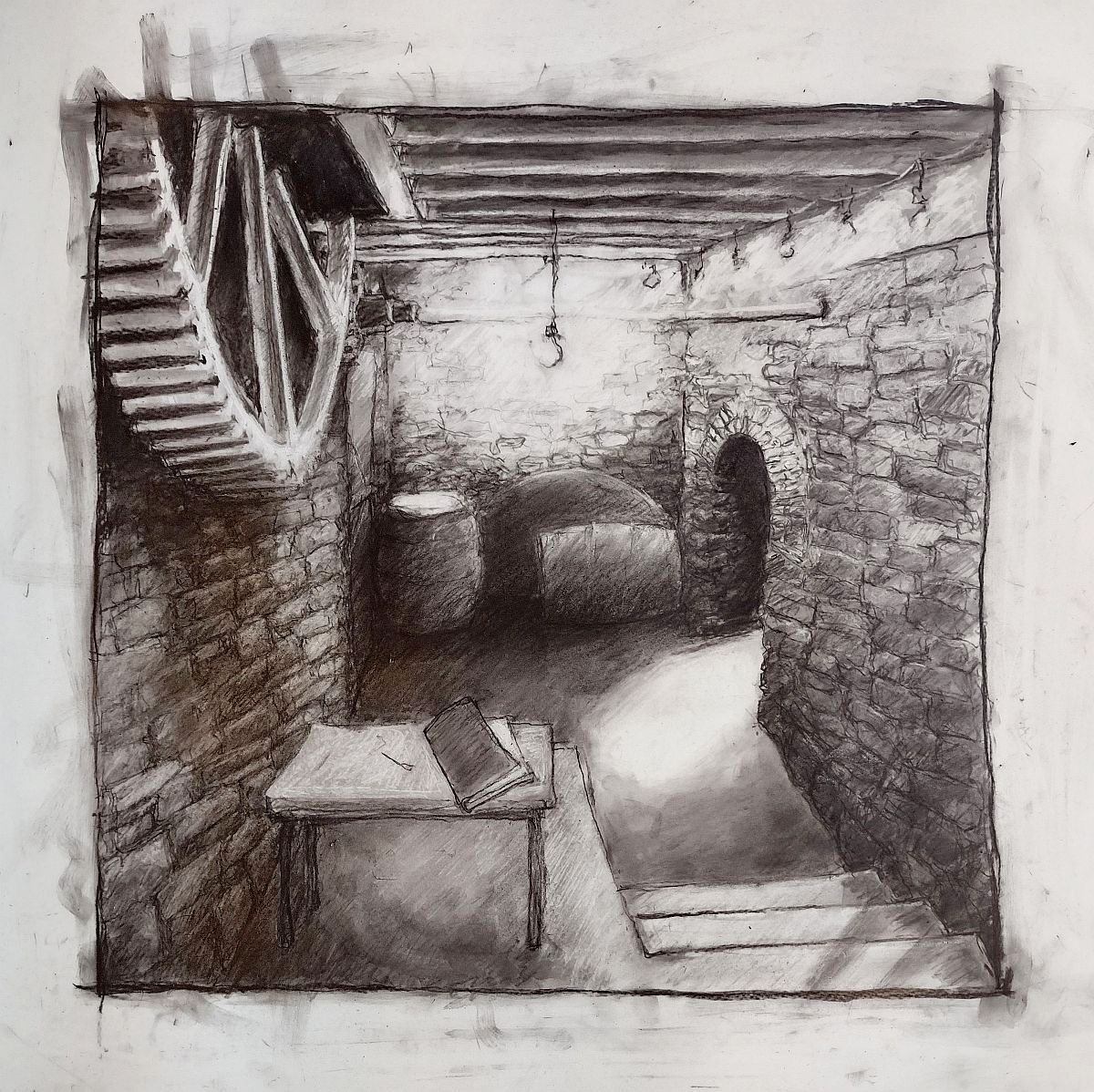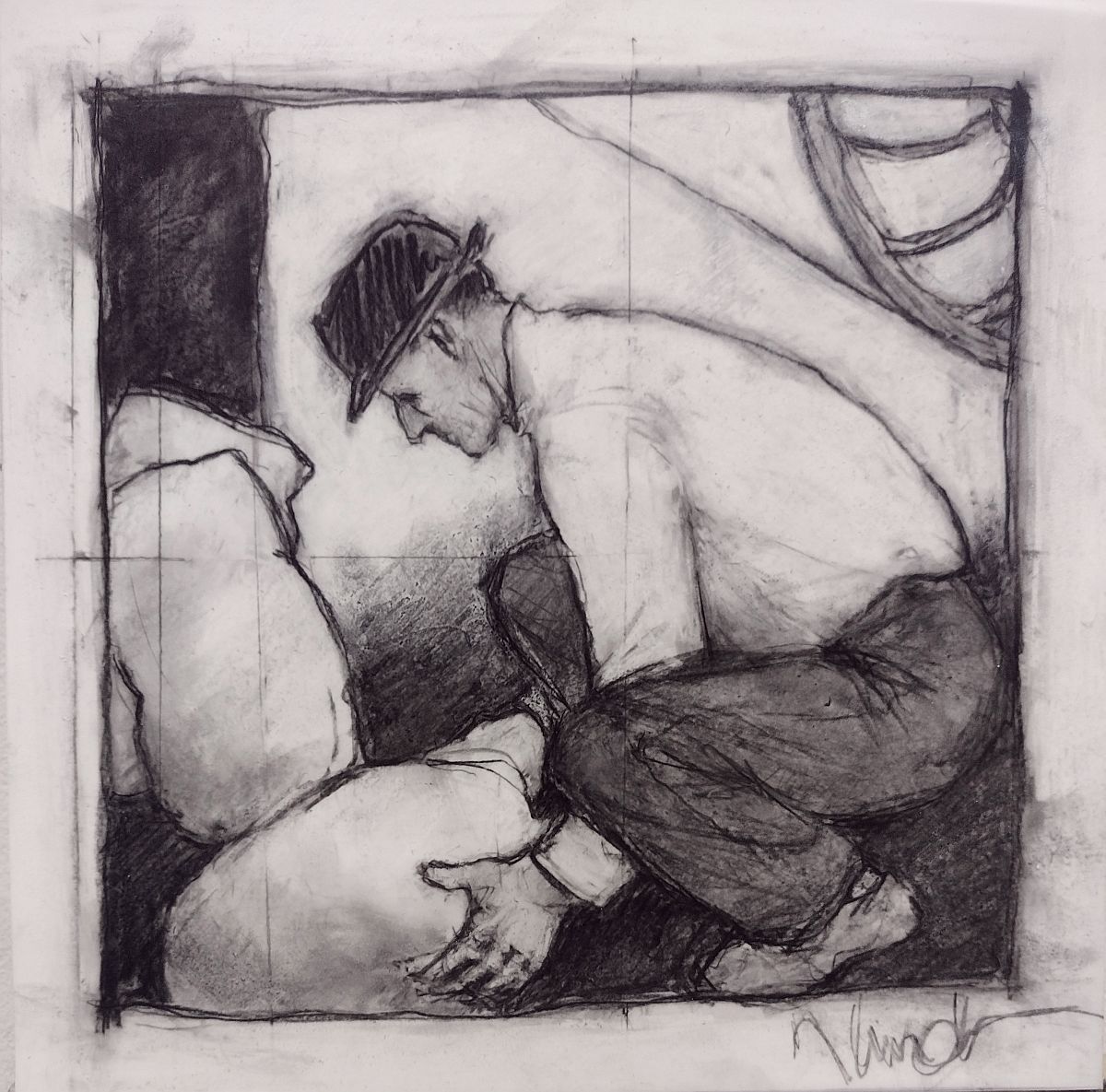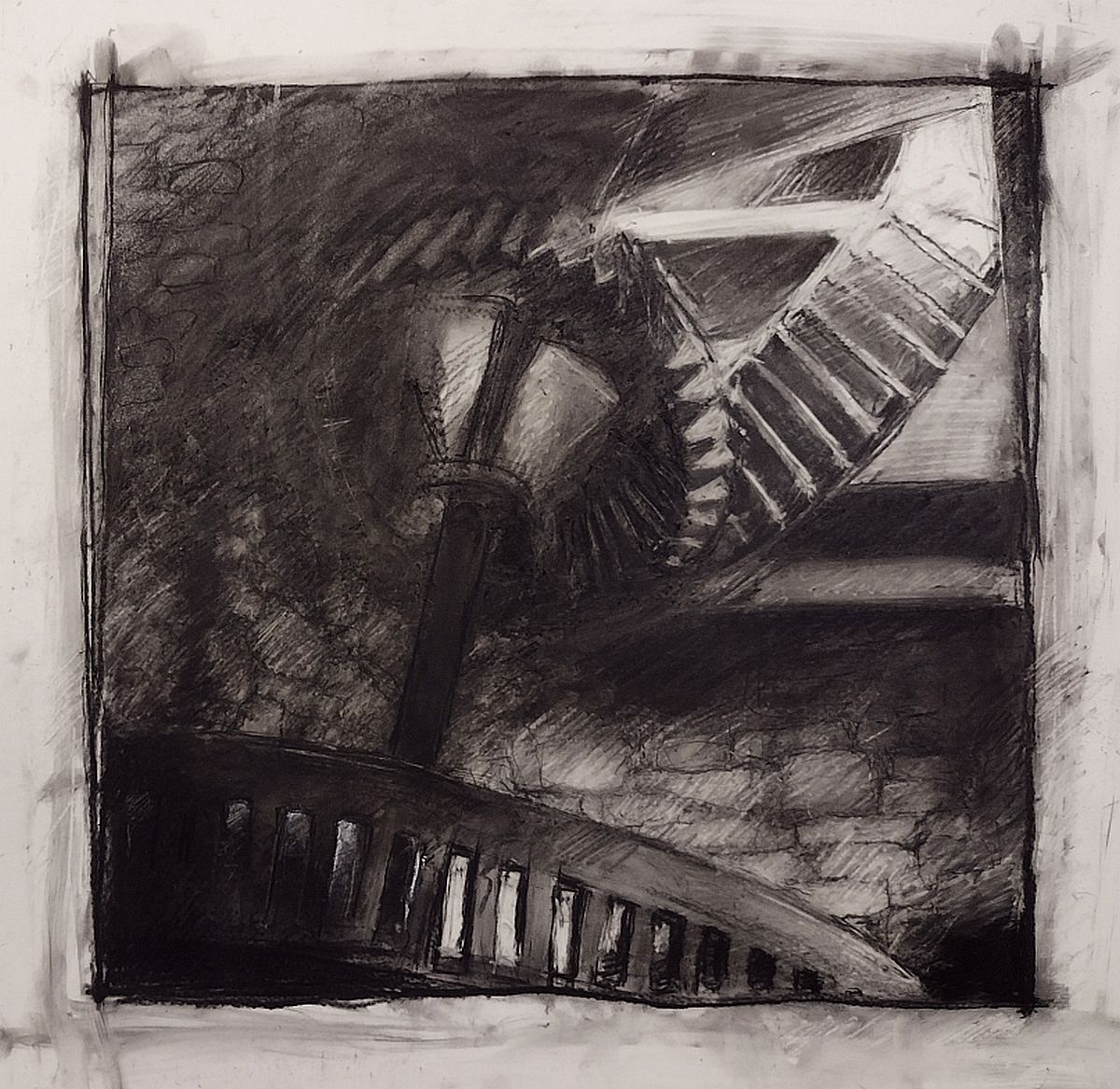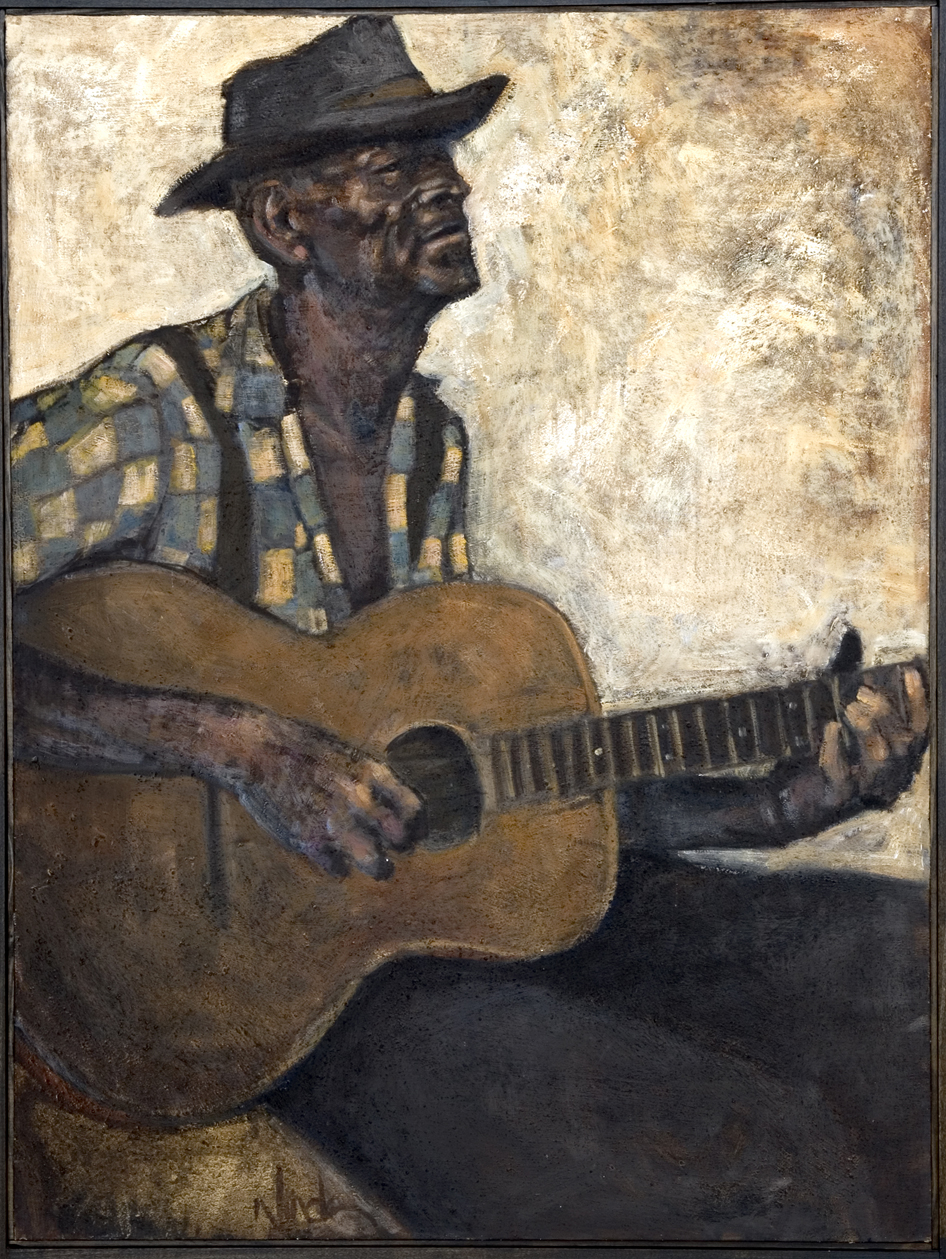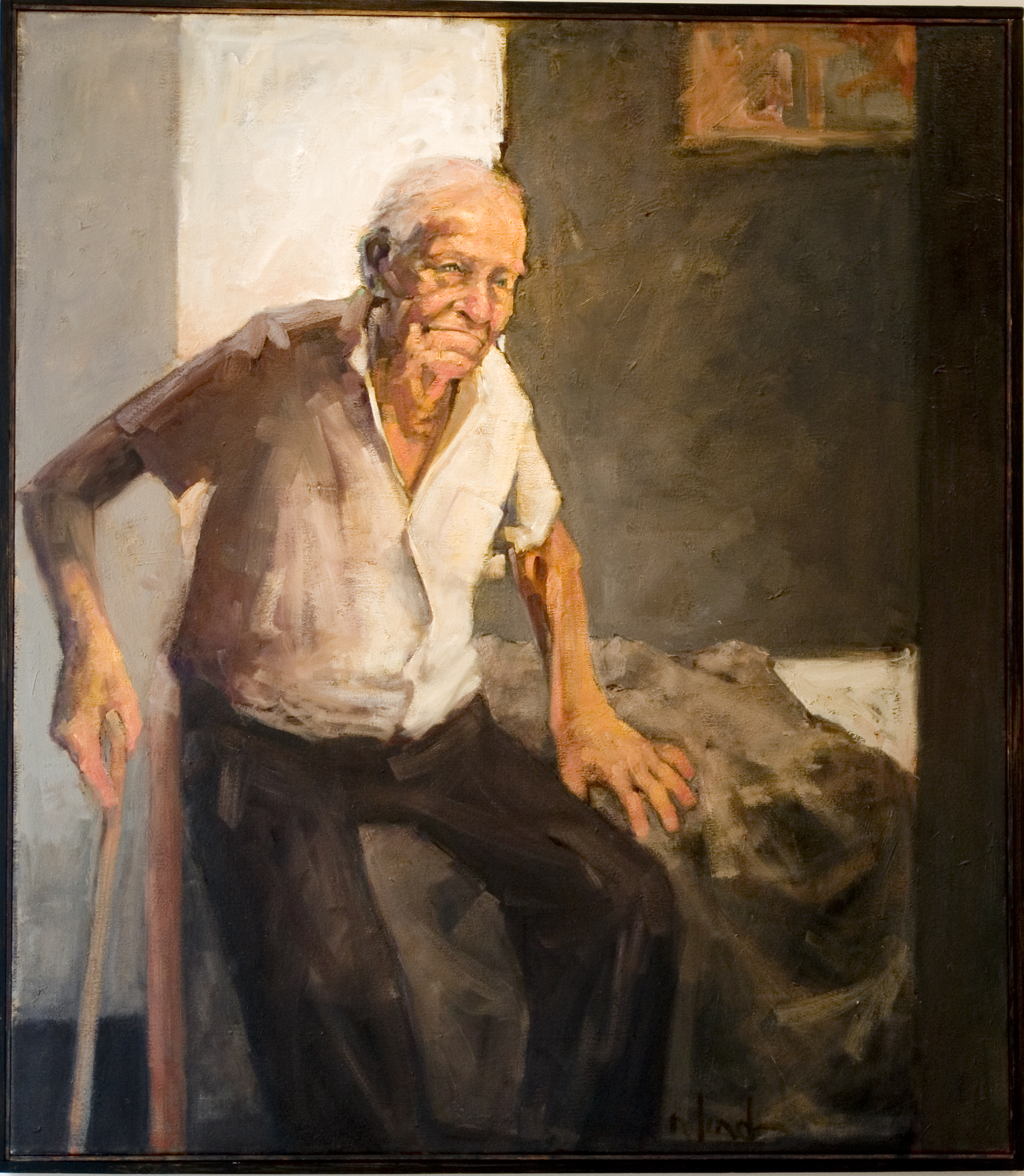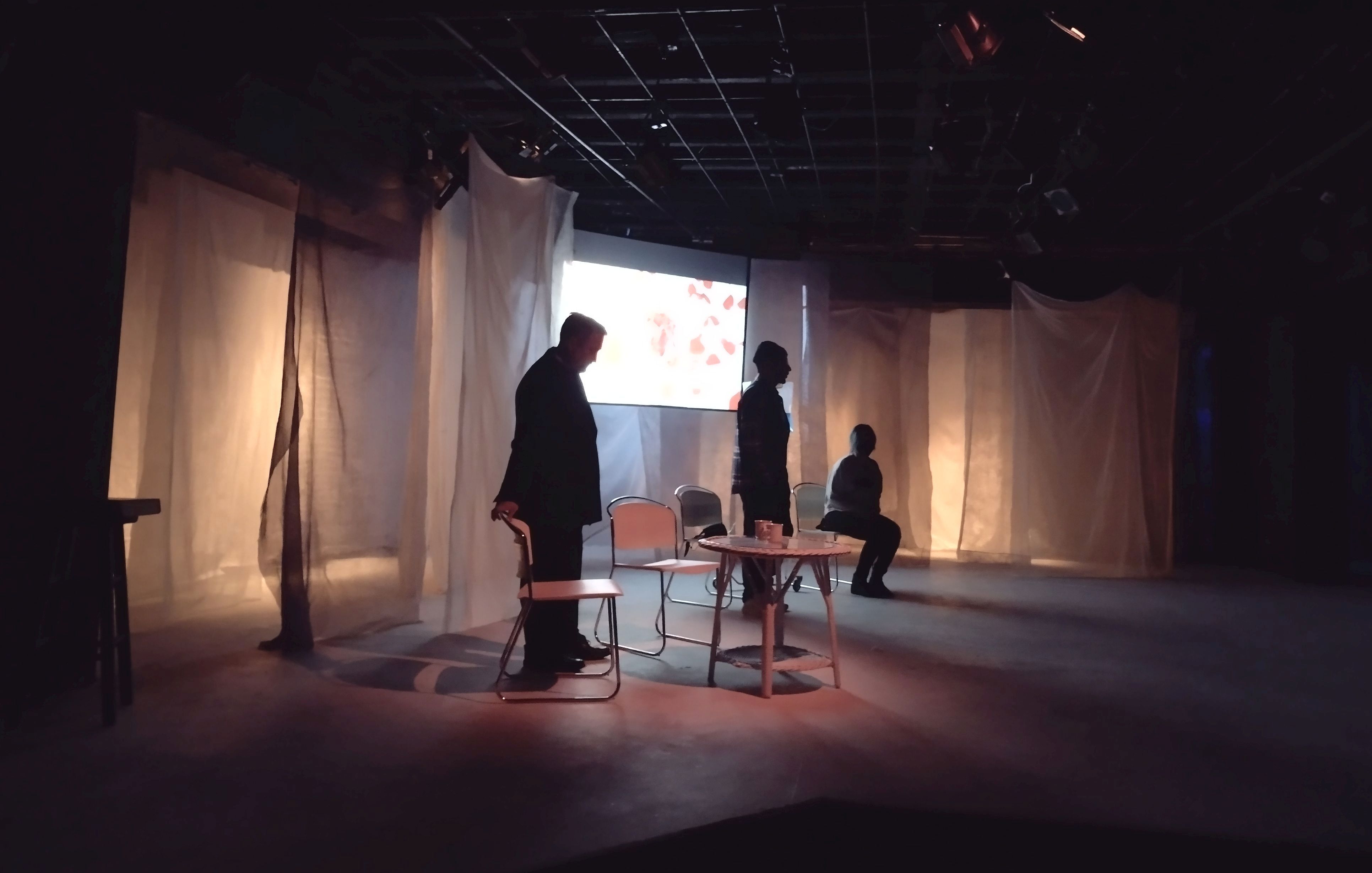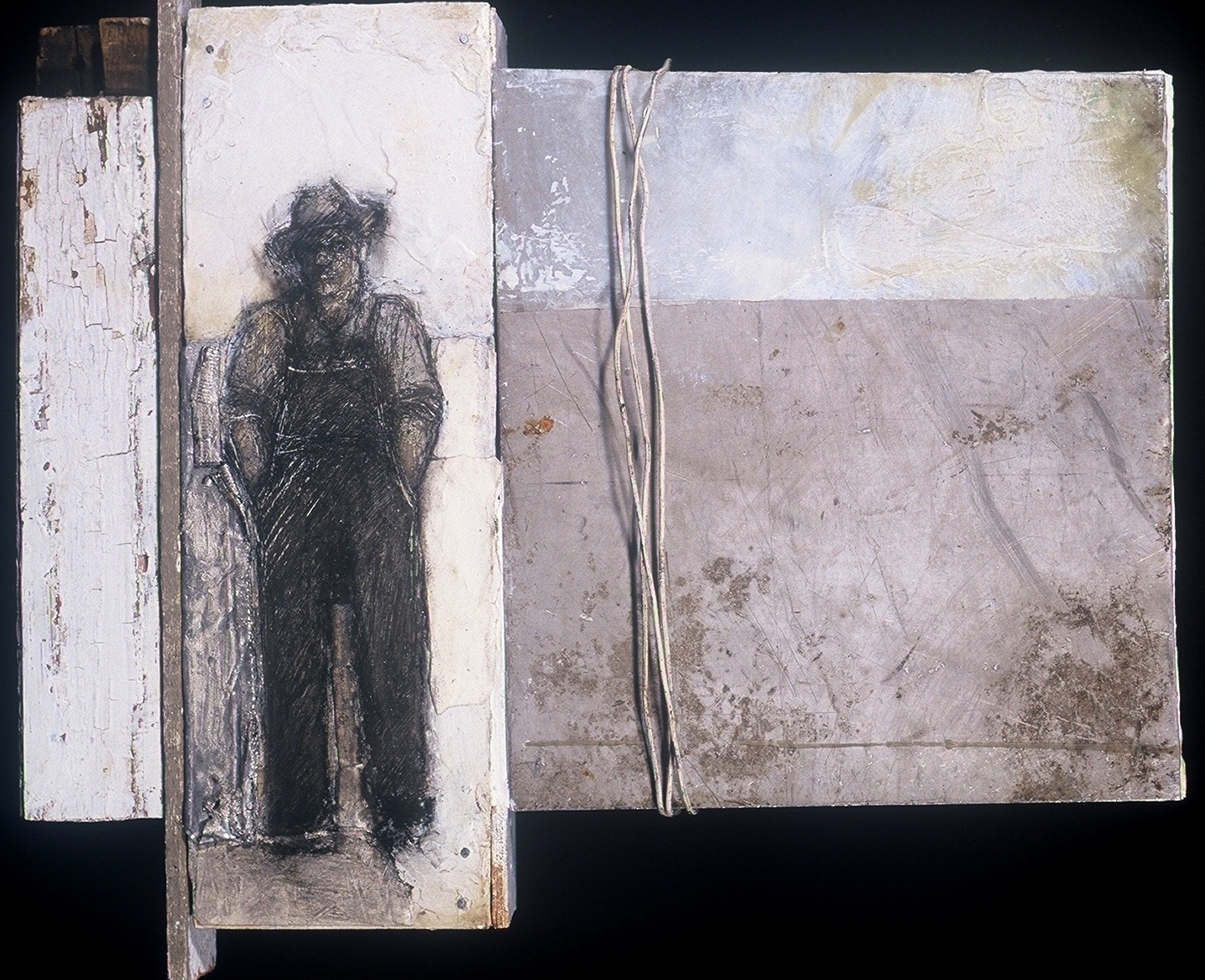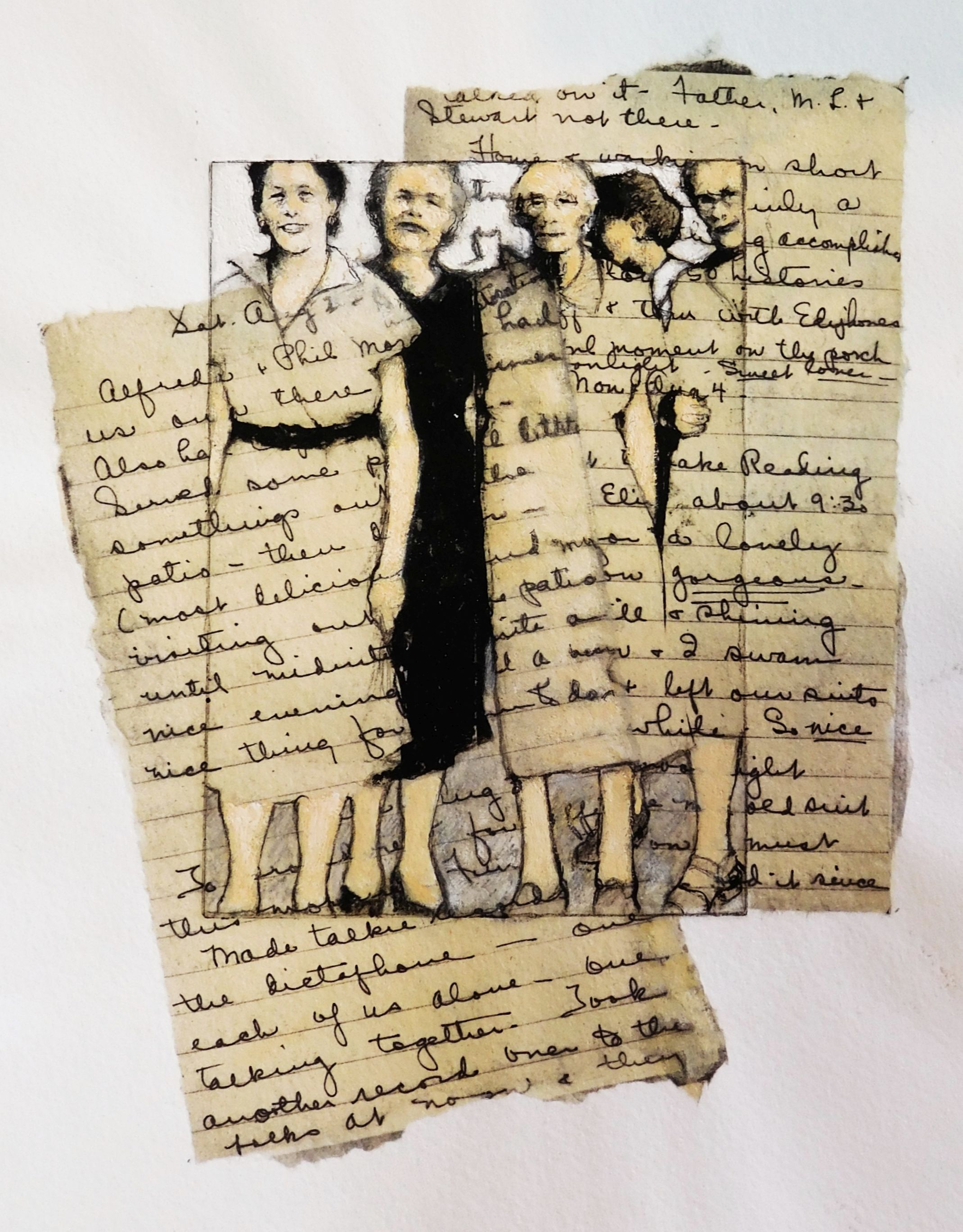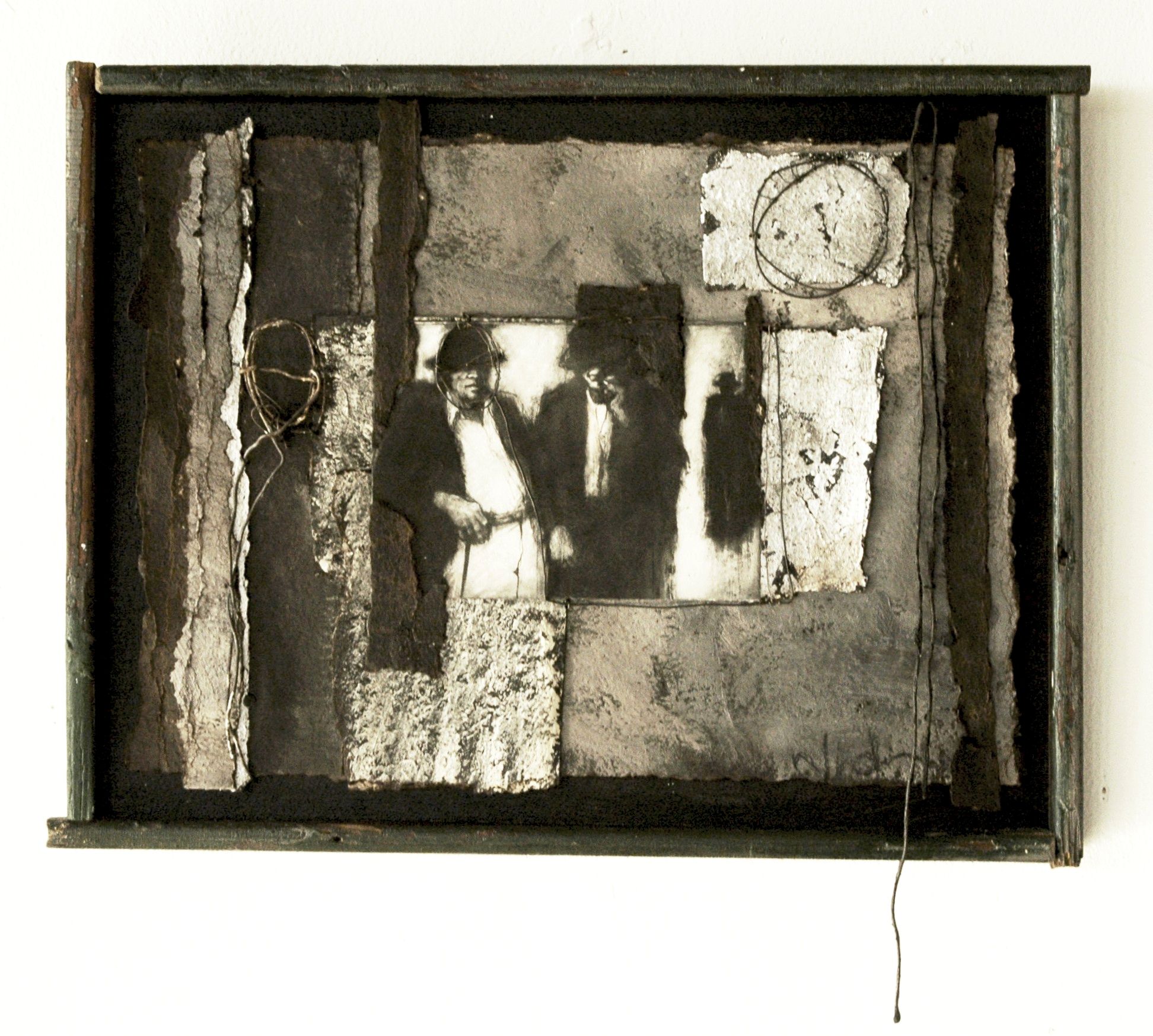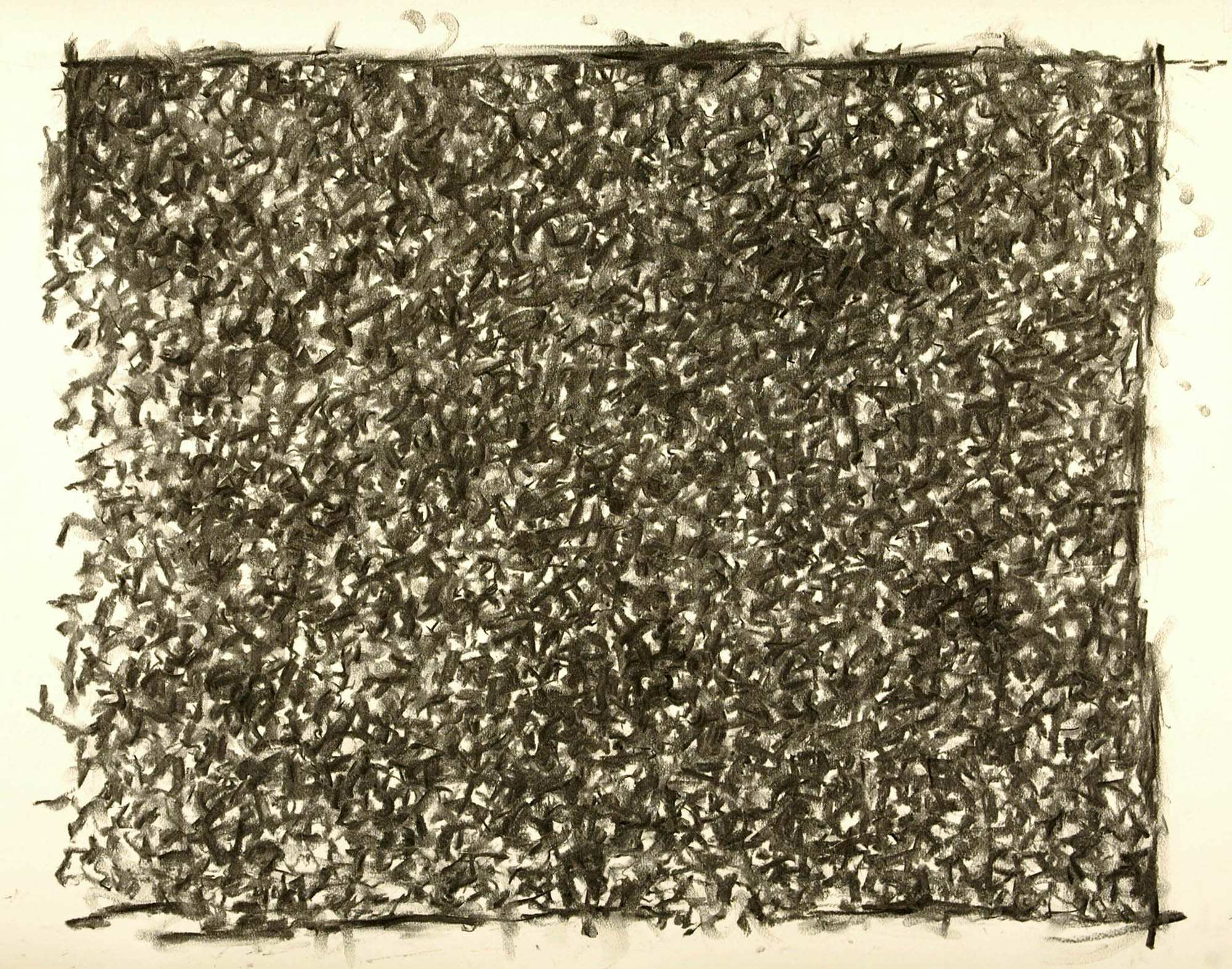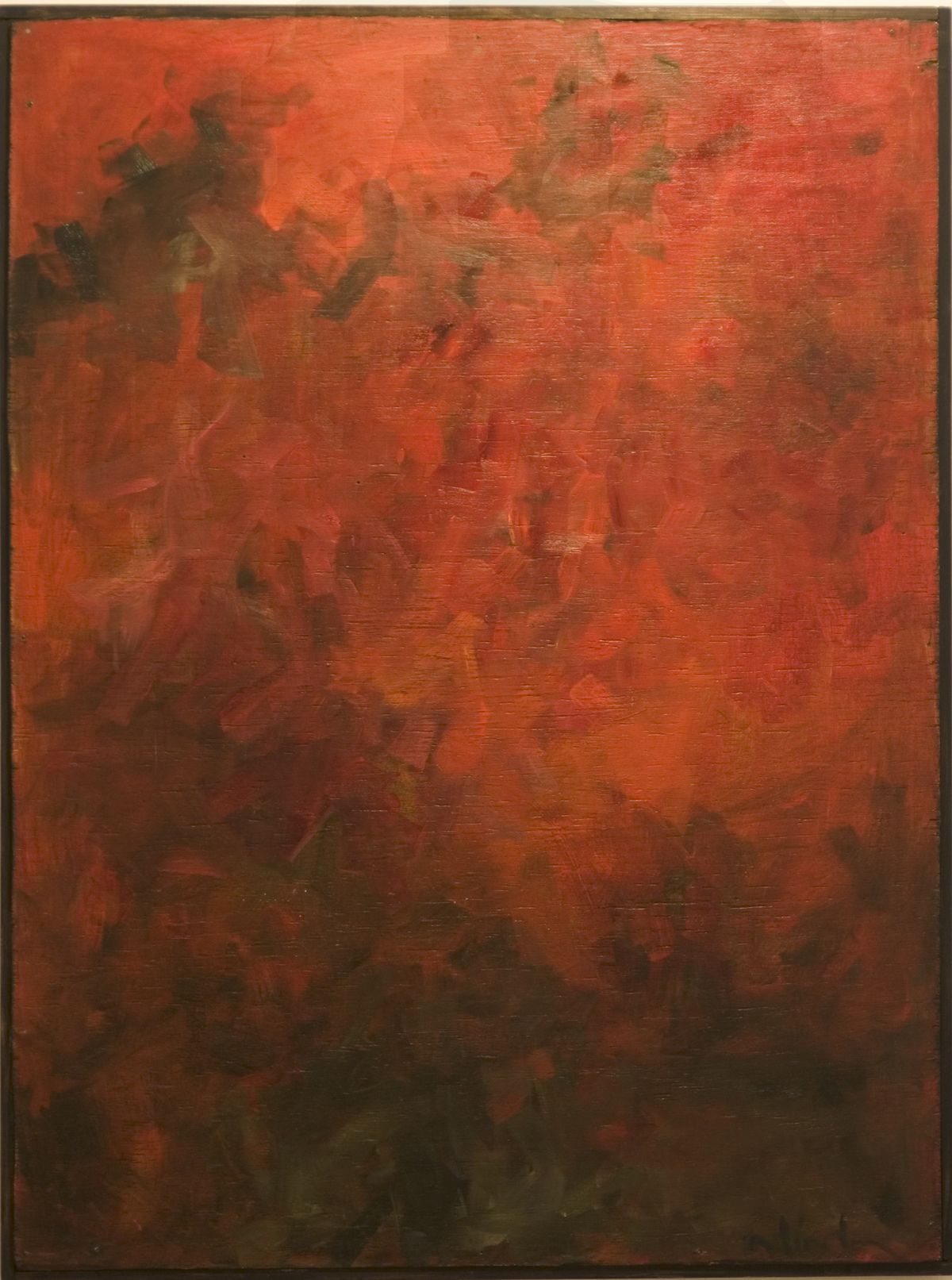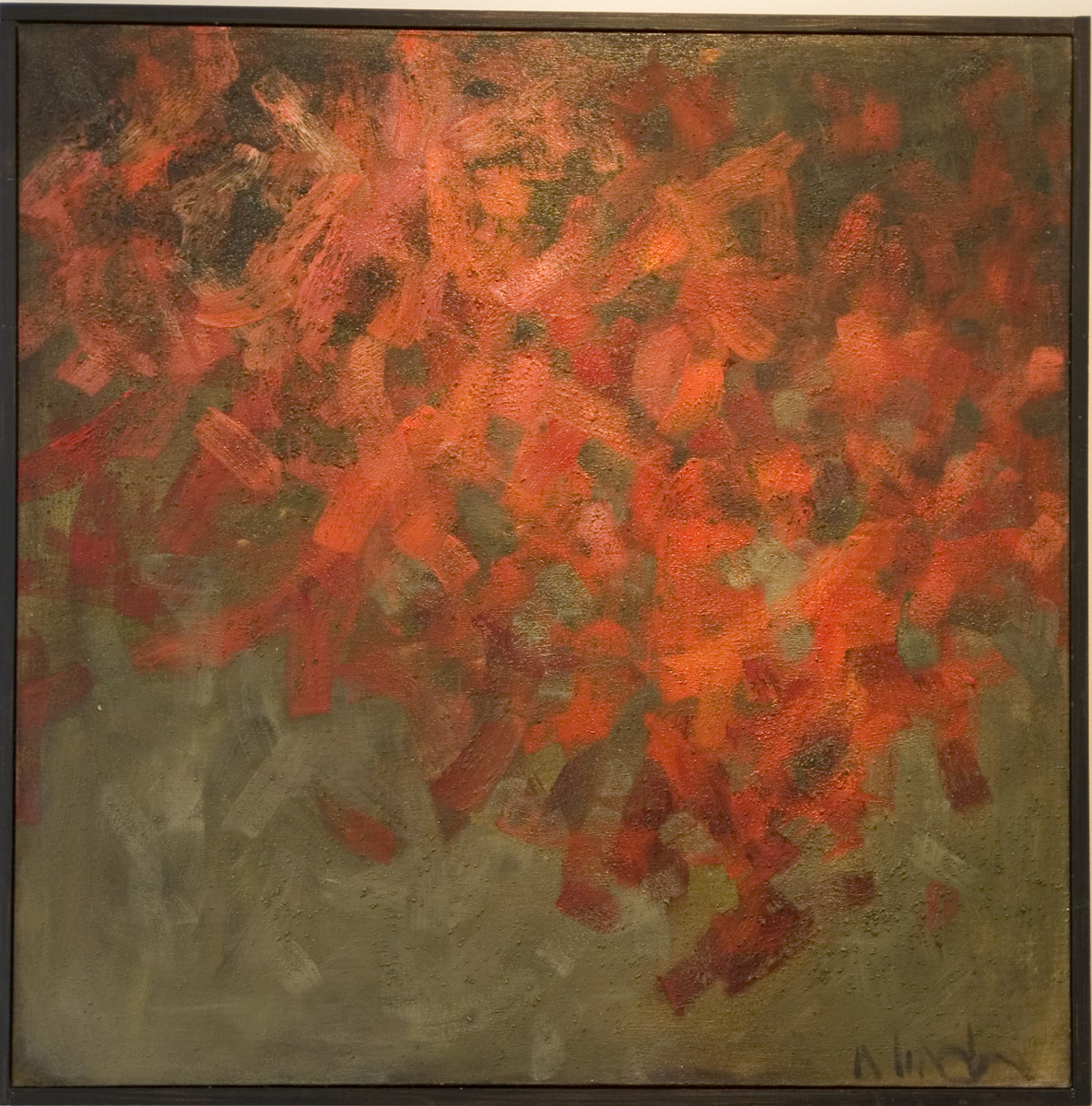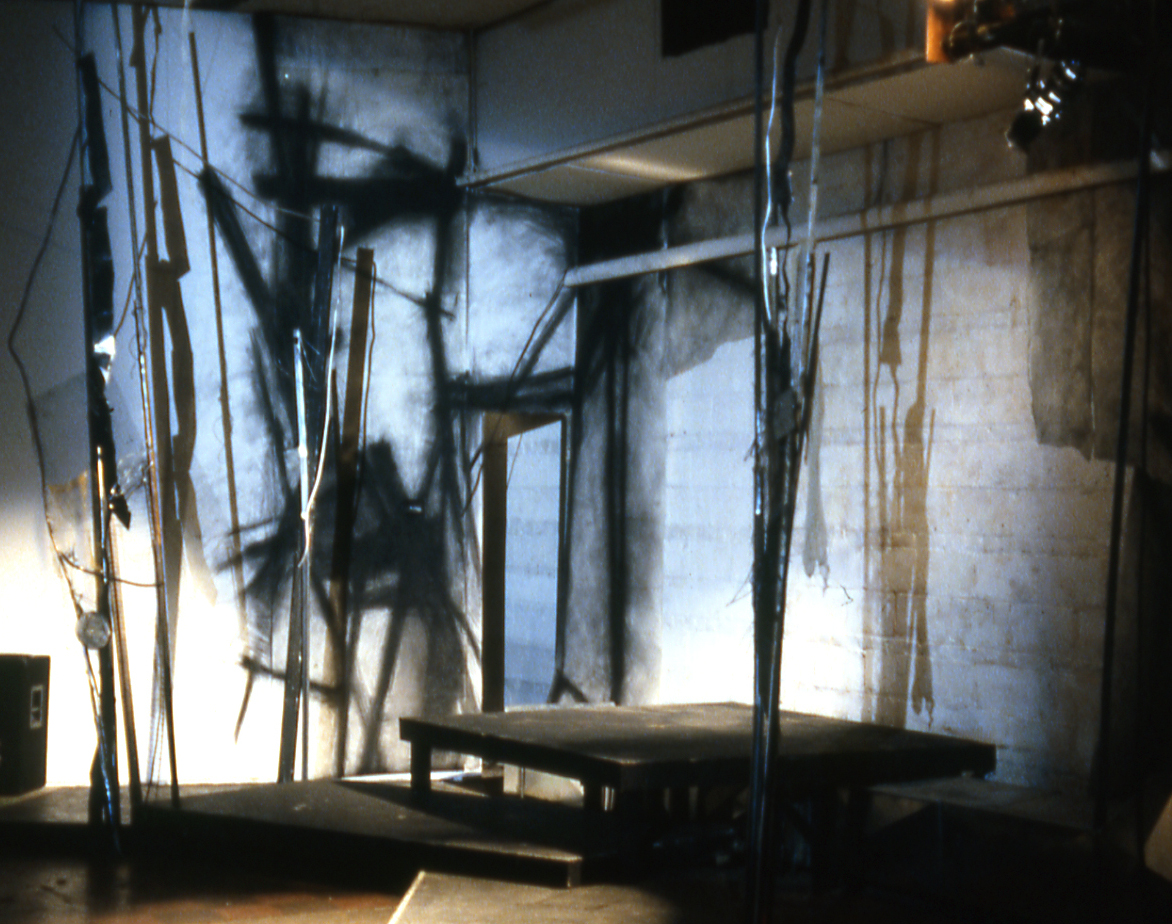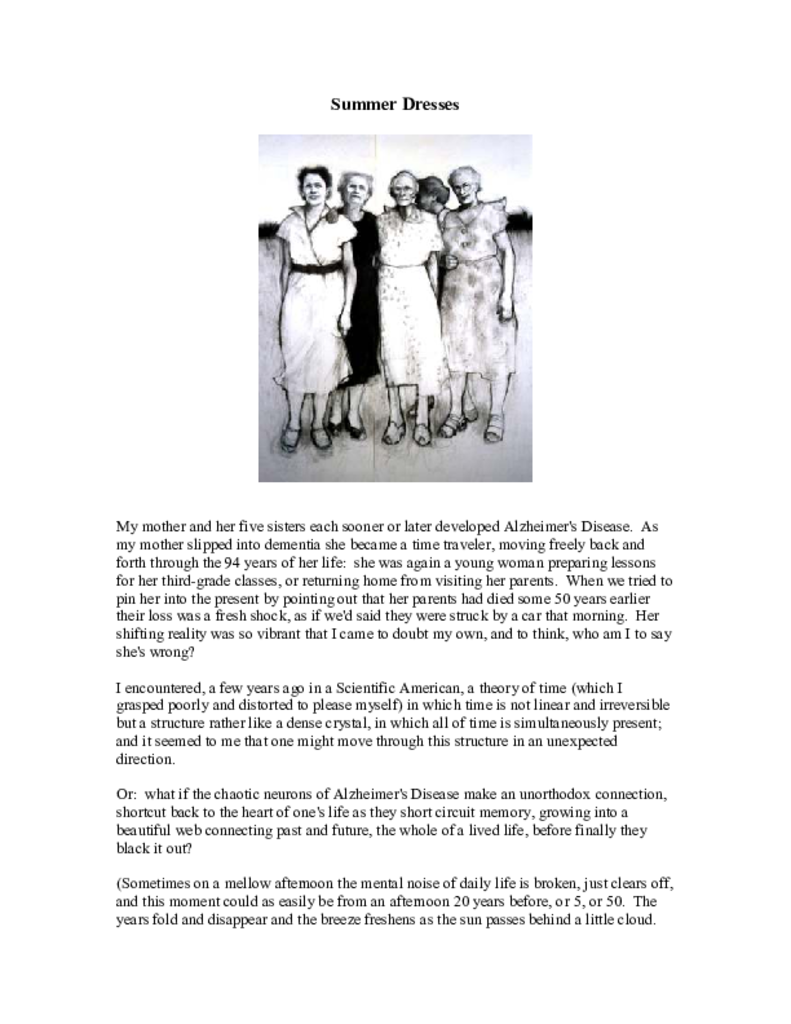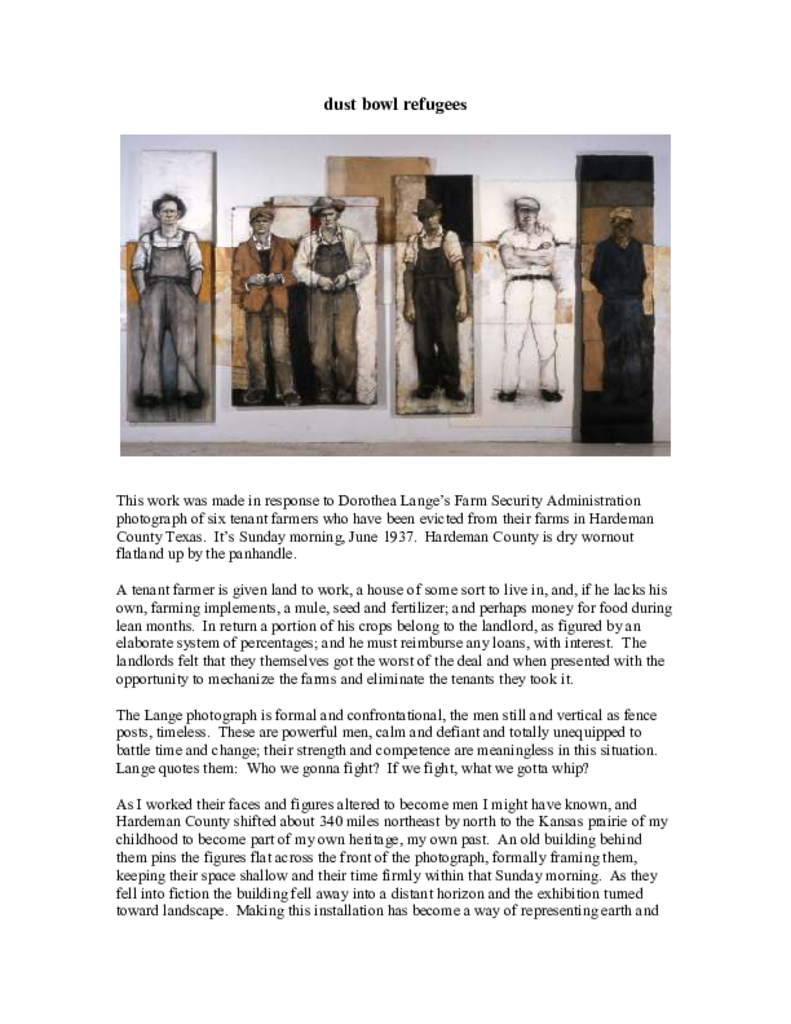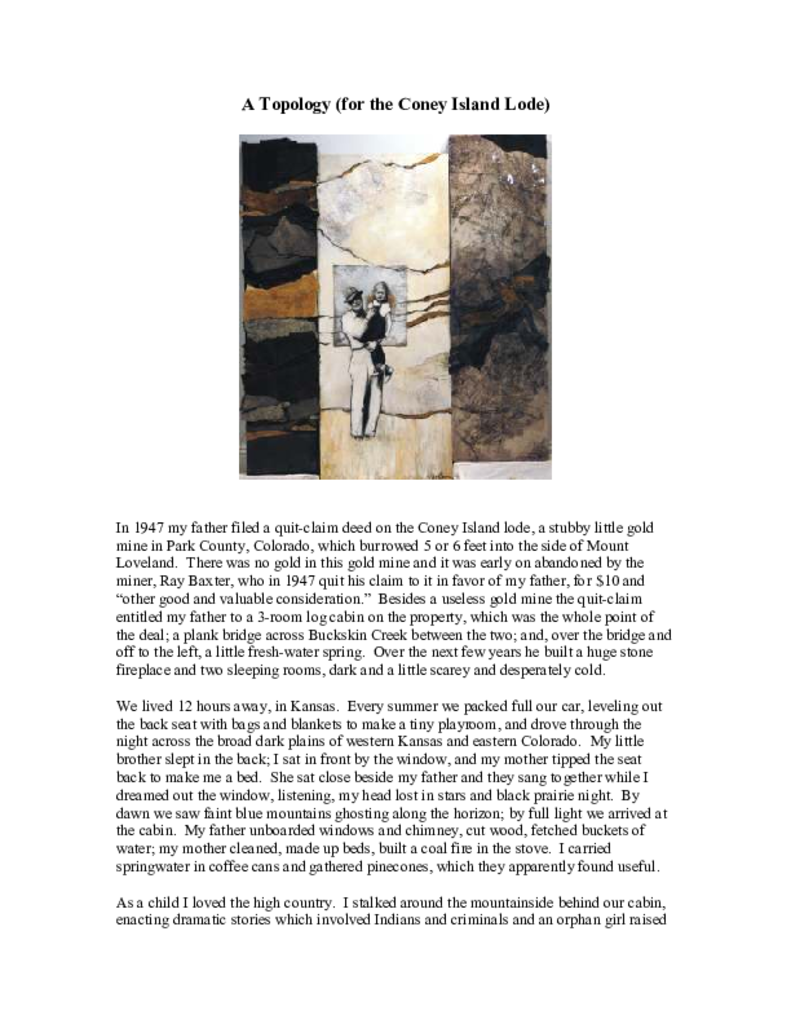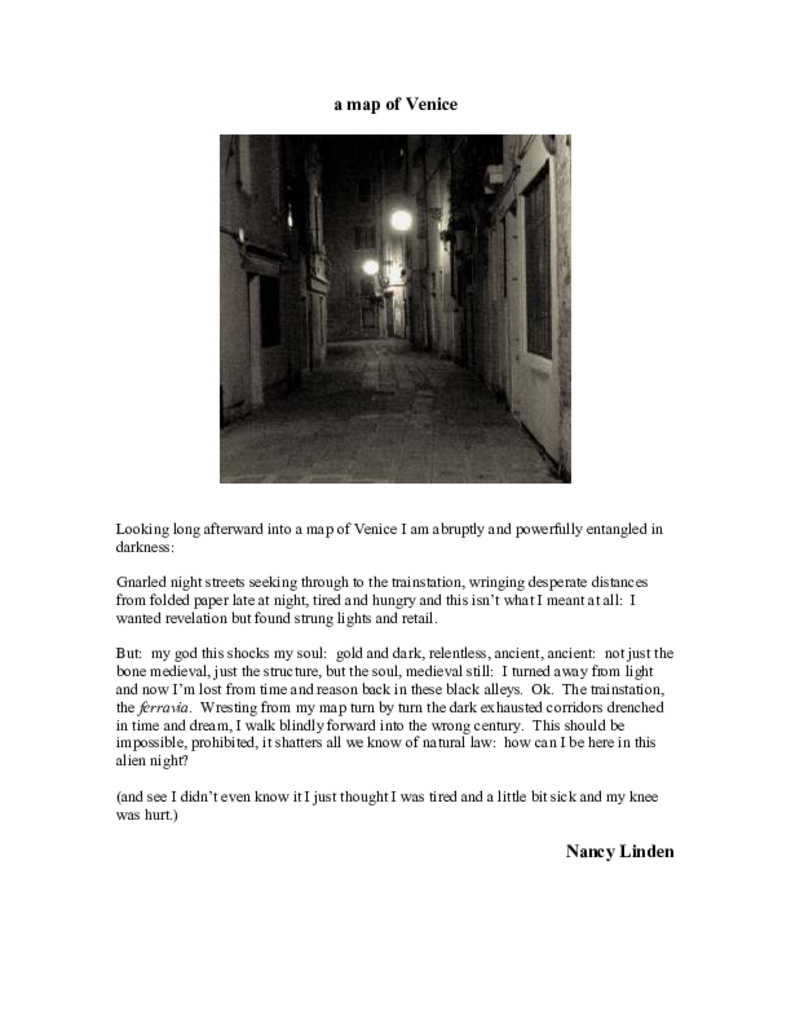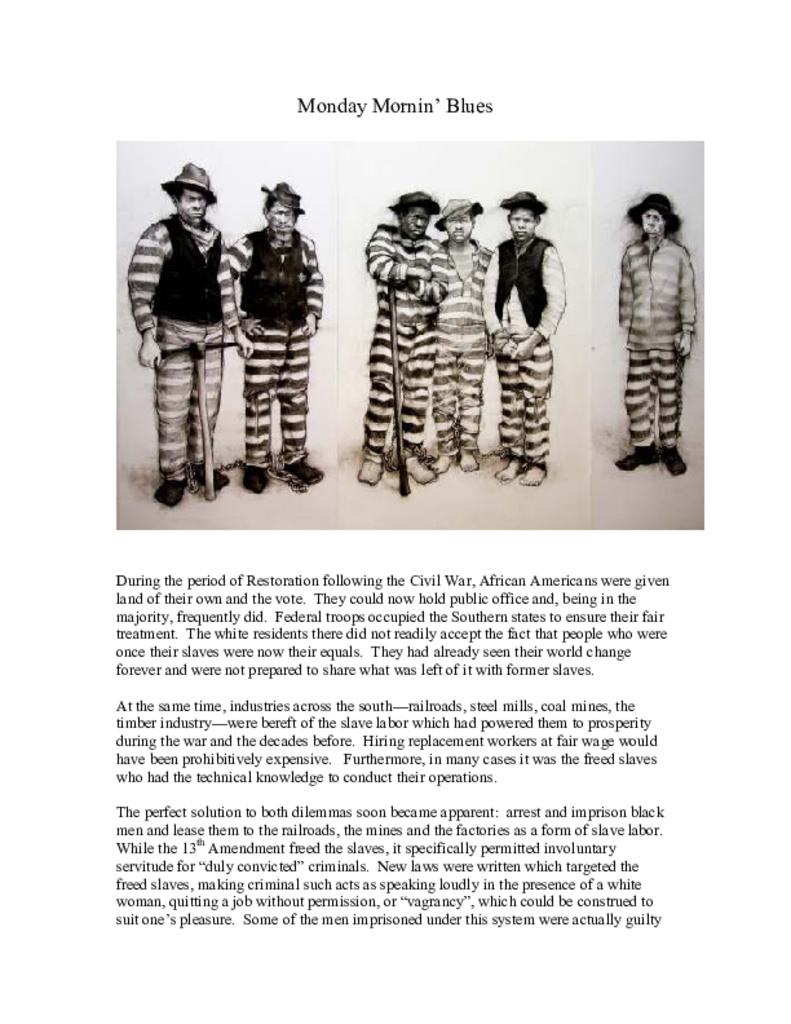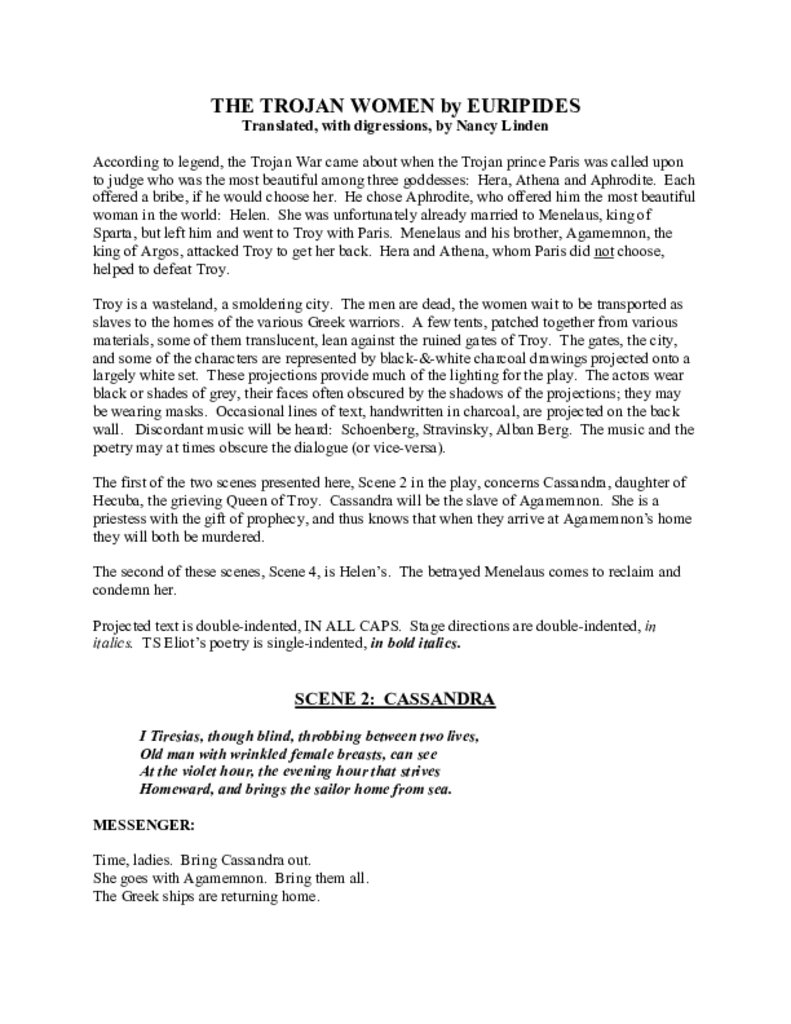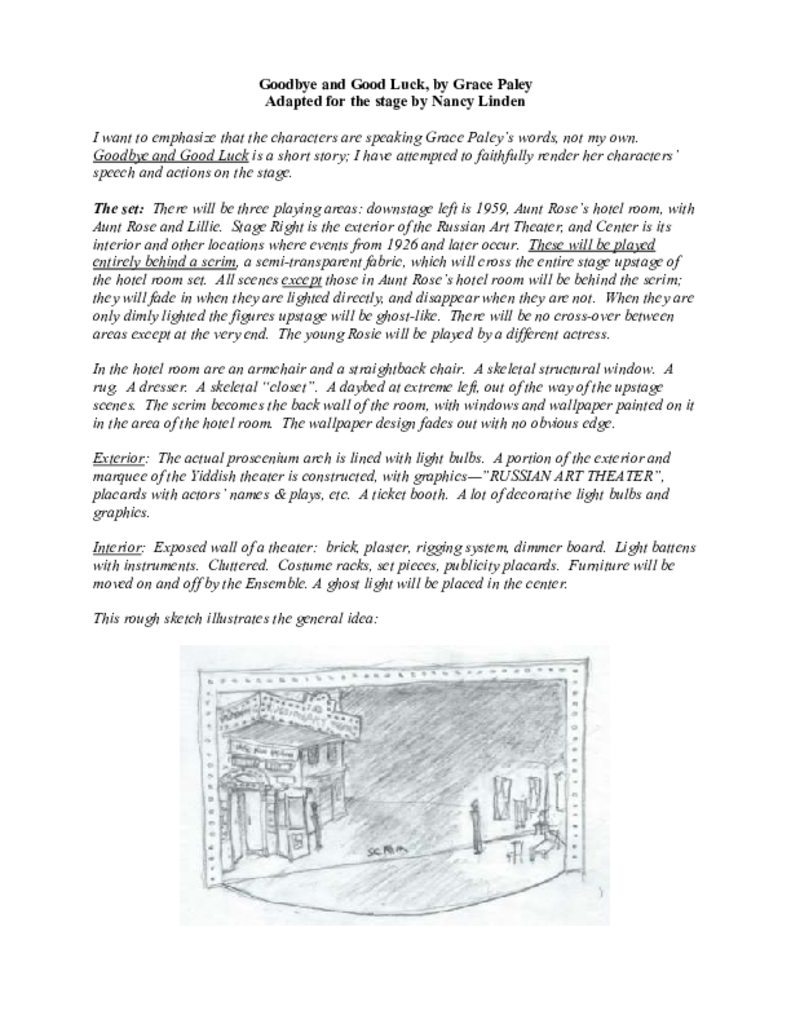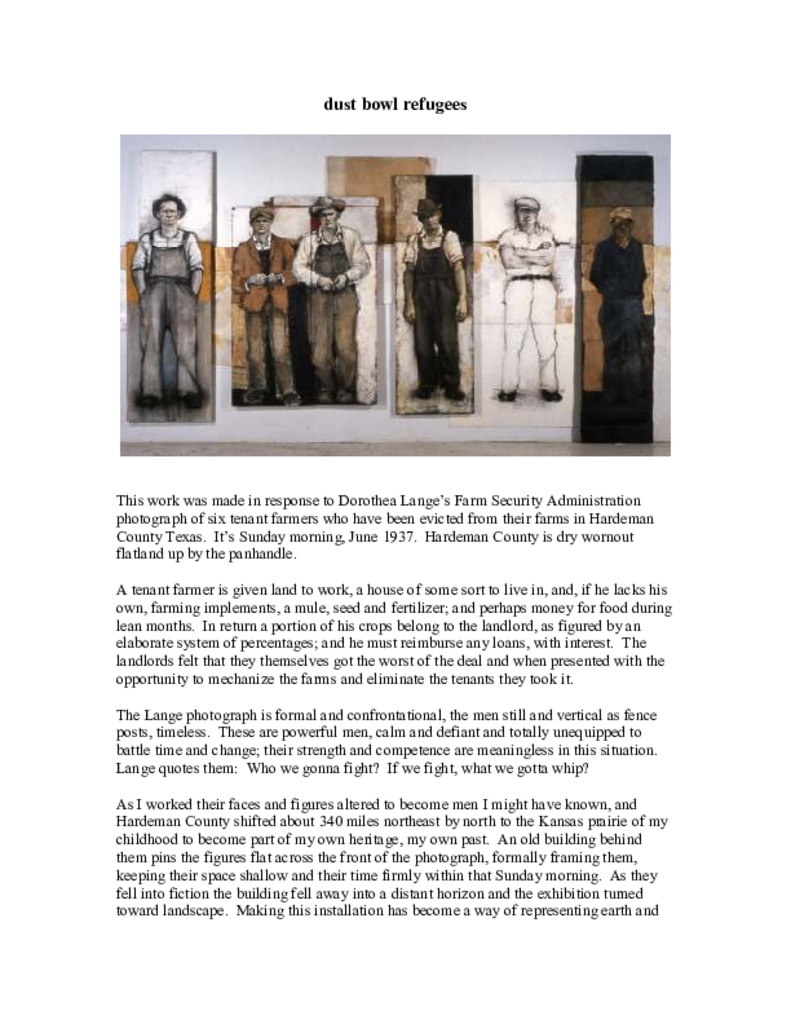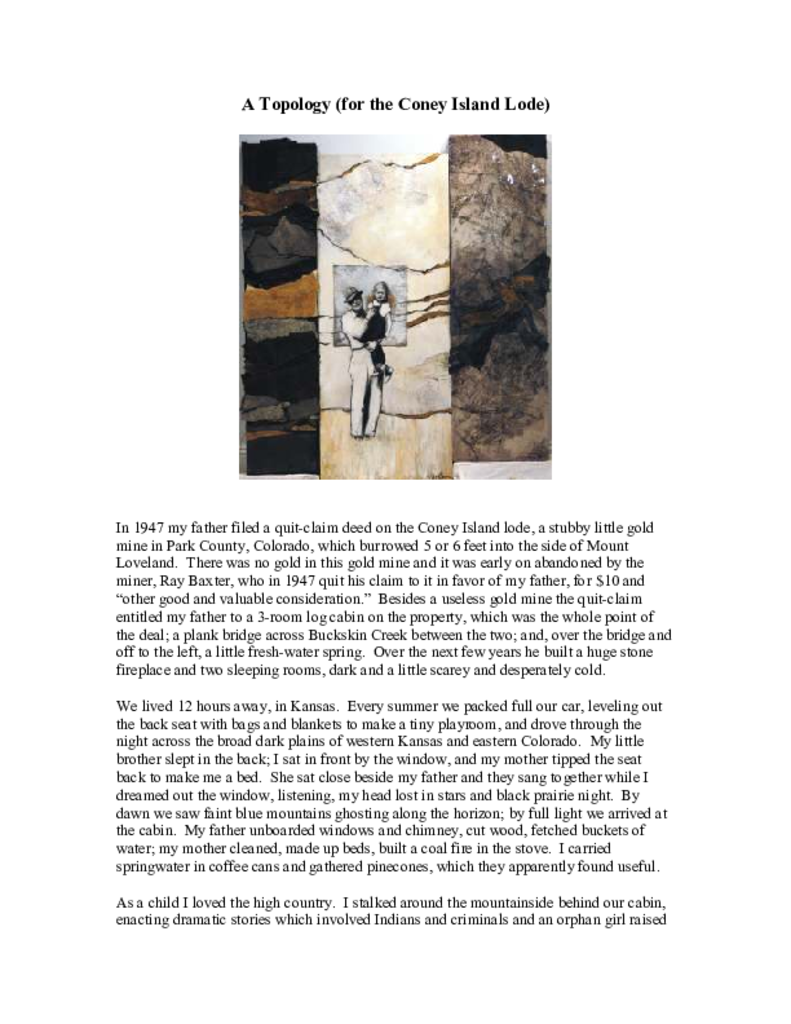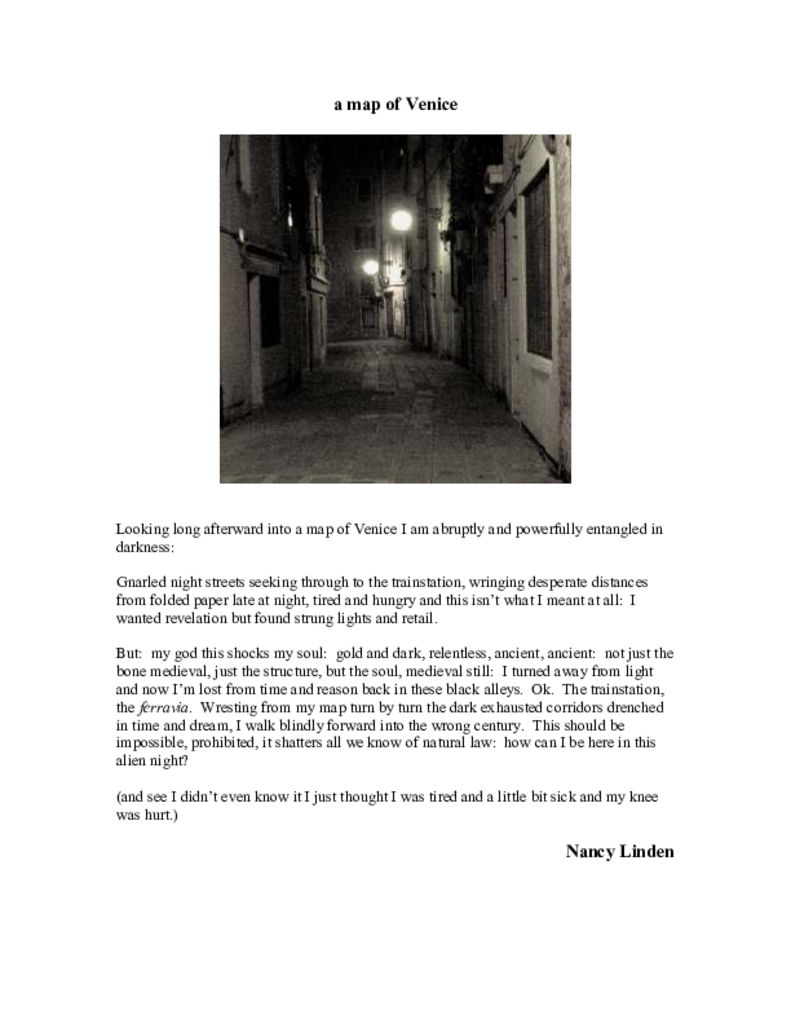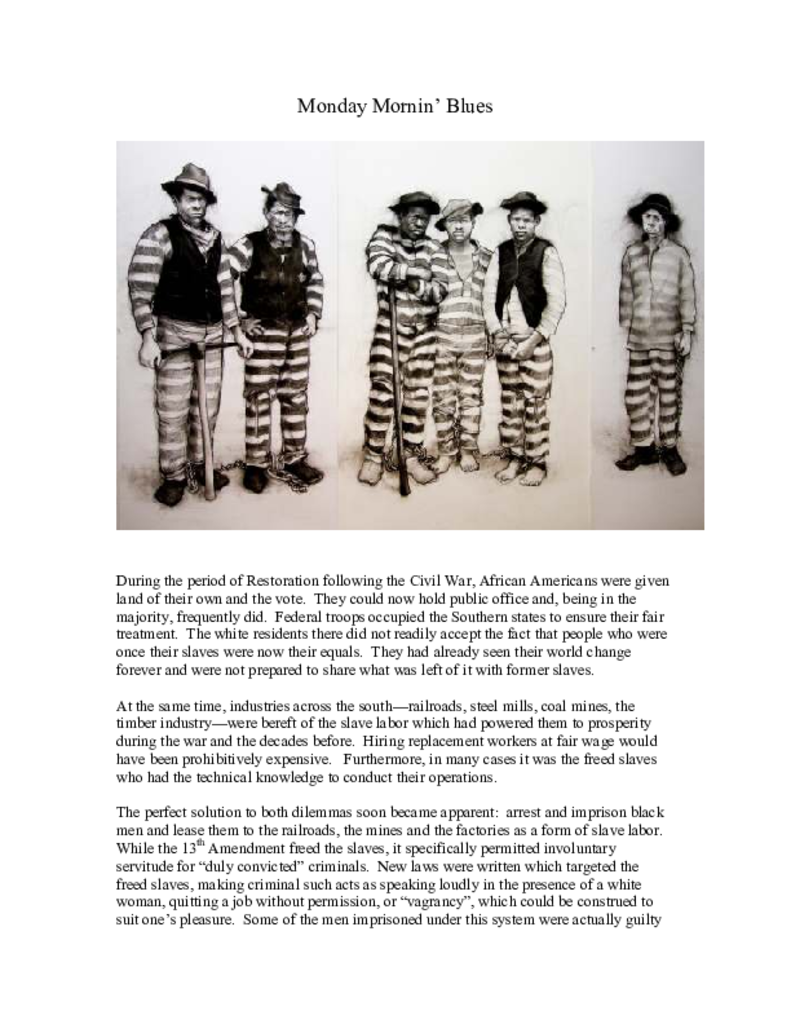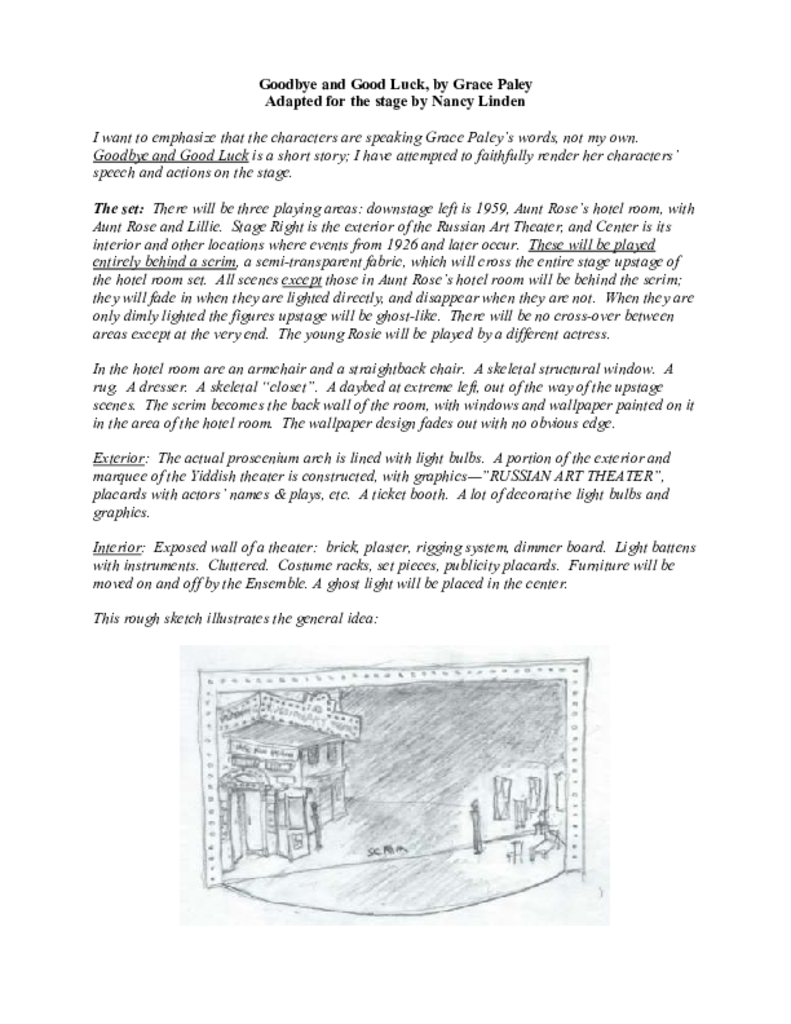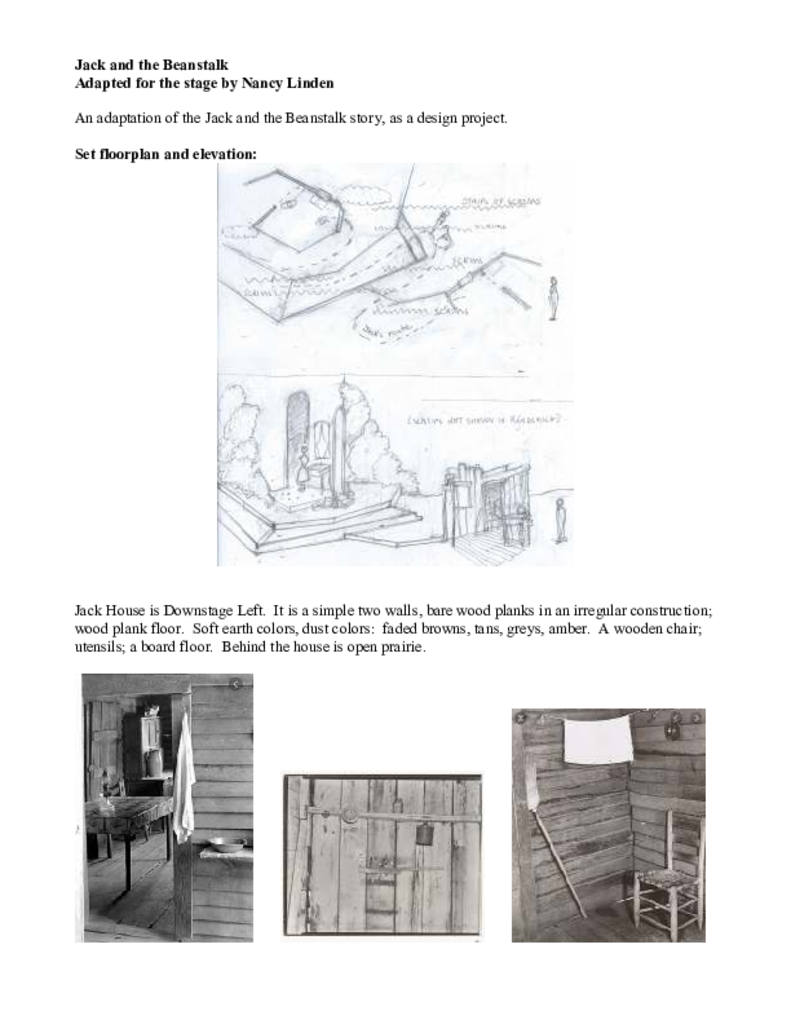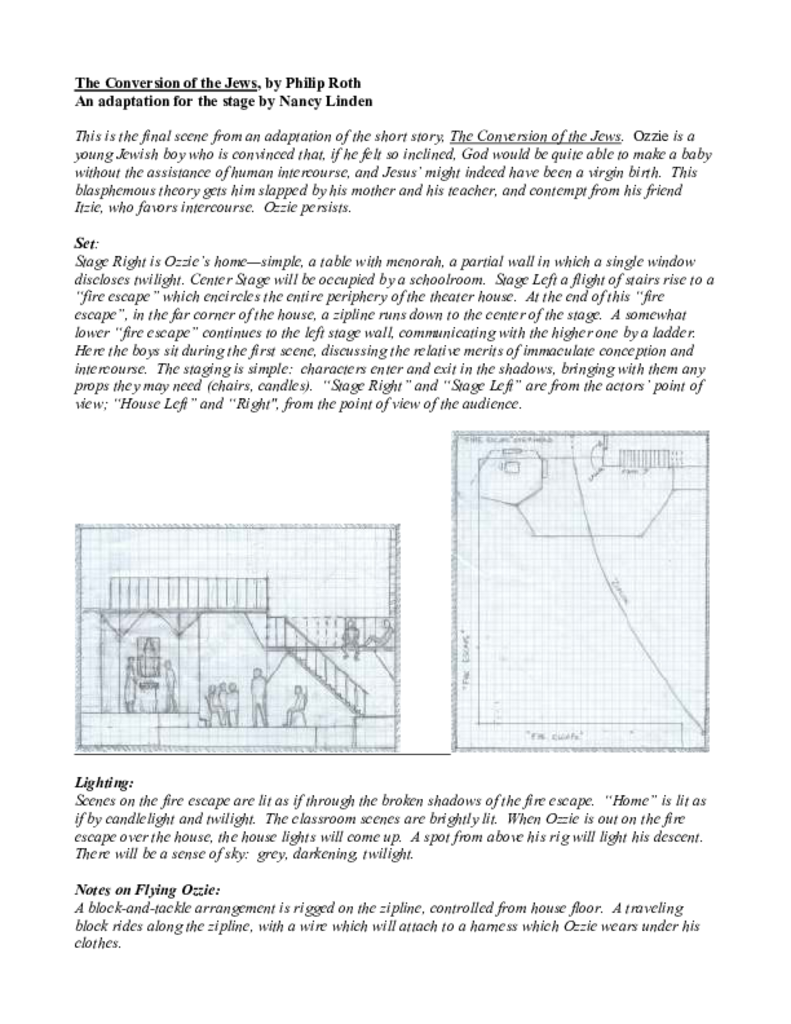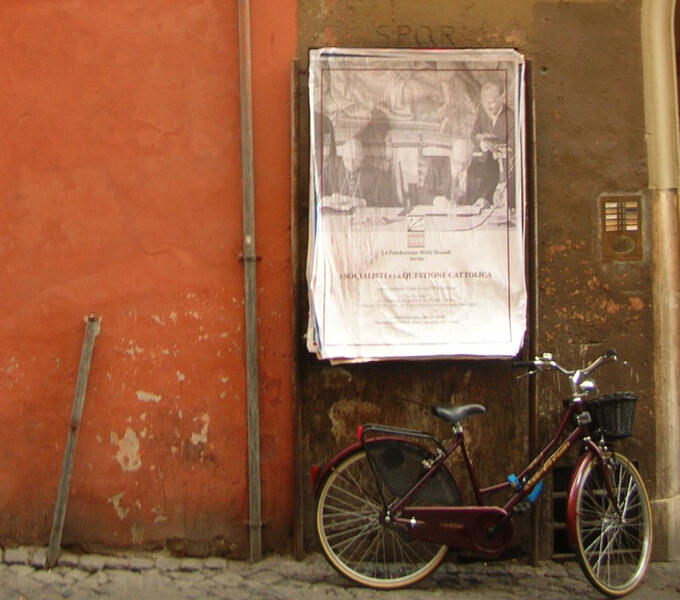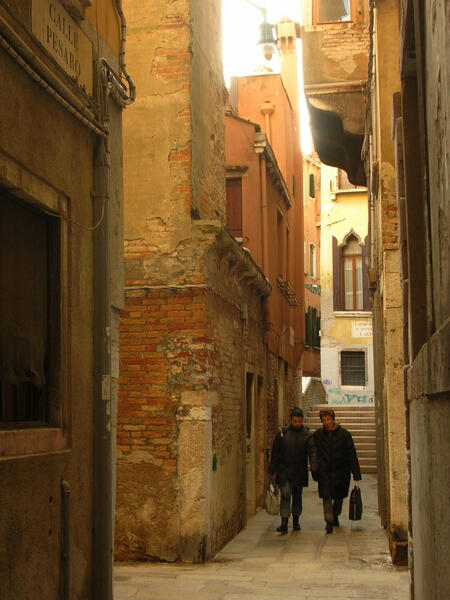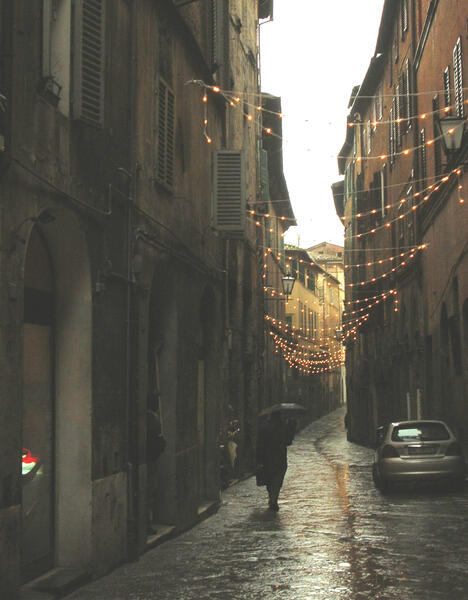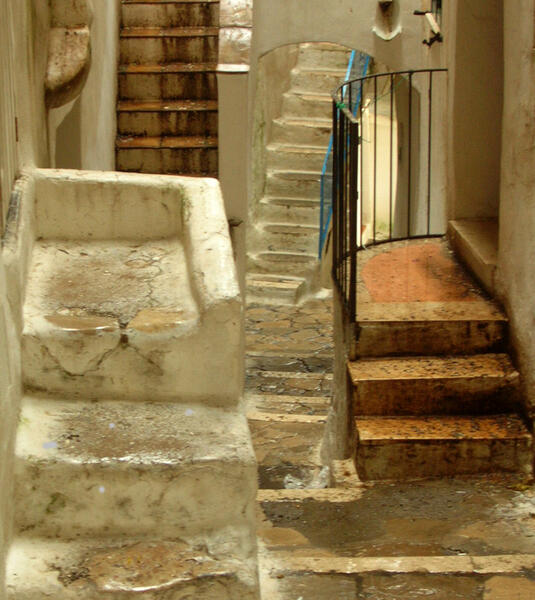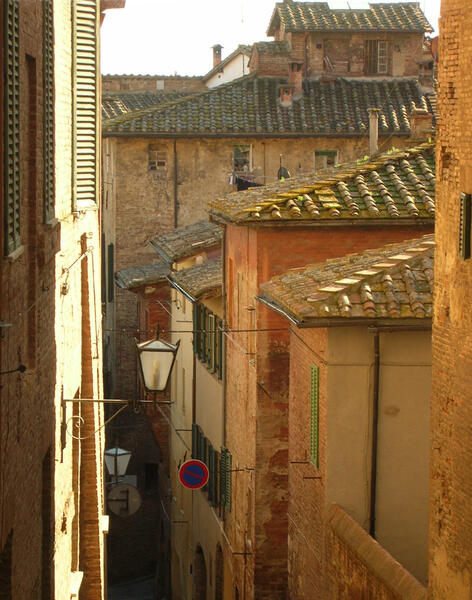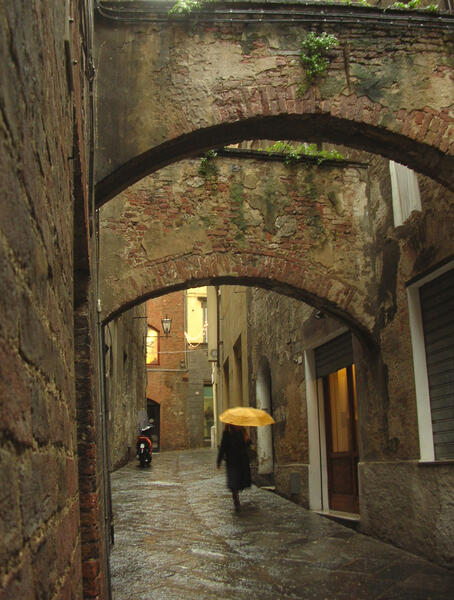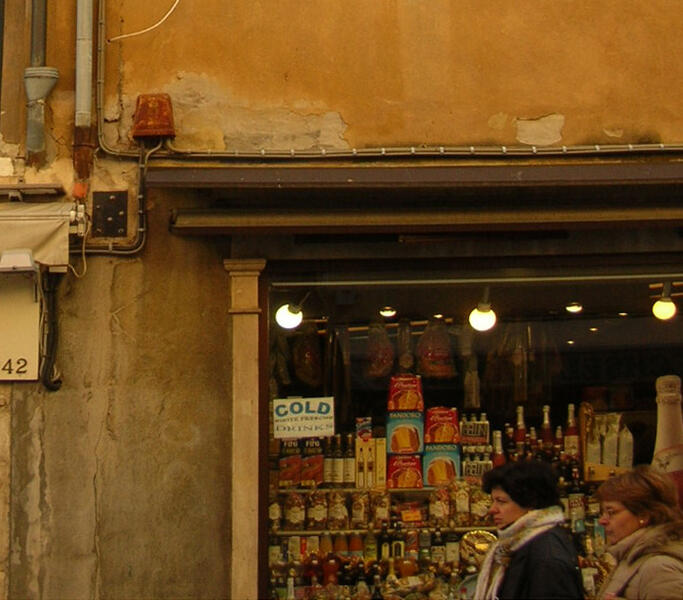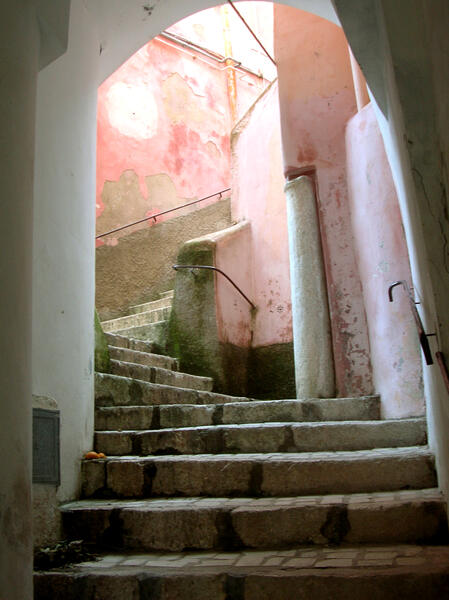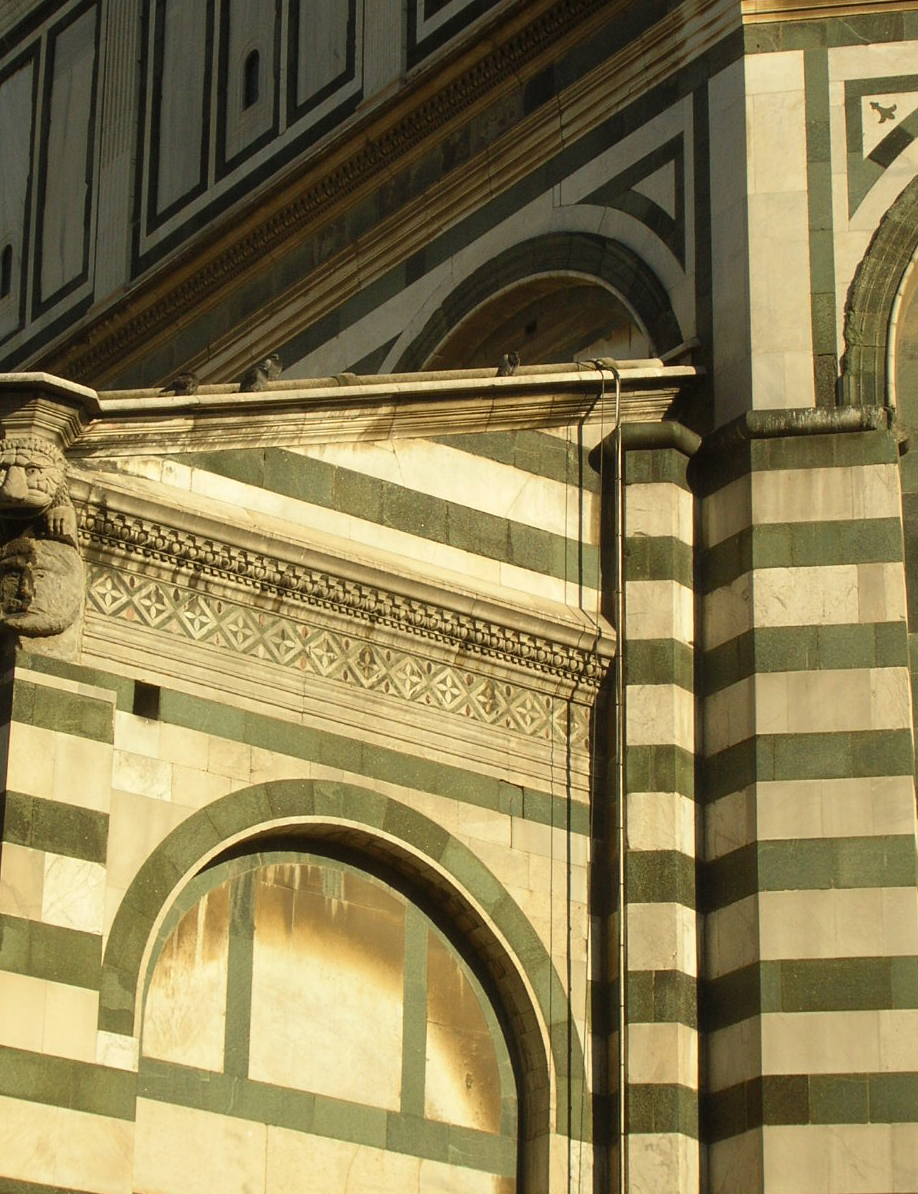Work samples
-
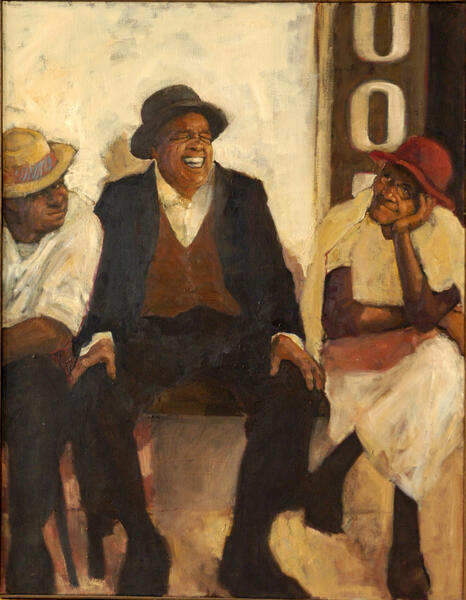 Sunday Afternoon"Sunday Afternoon". This painting is 54" x 42", oil and charcoal on canvas; it's based on a photograph Jack Delano took for the Farm Security Administration in 1941 in Heard County, Georgia. I've kept this painting in my personal collection; it makes me happy to look at these people.
Sunday Afternoon"Sunday Afternoon". This painting is 54" x 42", oil and charcoal on canvas; it's based on a photograph Jack Delano took for the Farm Security Administration in 1941 in Heard County, Georgia. I've kept this painting in my personal collection; it makes me happy to look at these people. -
once it was this
This is a charcoal drawing in stop-motion animation, a technique pirated from William Kentridge. I created it to accompany a poem I wrote. My mother and four of her five sisters gather for a photograph in our back yard at a family reunion in the summer of 1957. Sooner or later each of the sisters, including my mother, developed Alzheimer's Disease; they walk out of the picture as they depart from what we think of as reality.
-
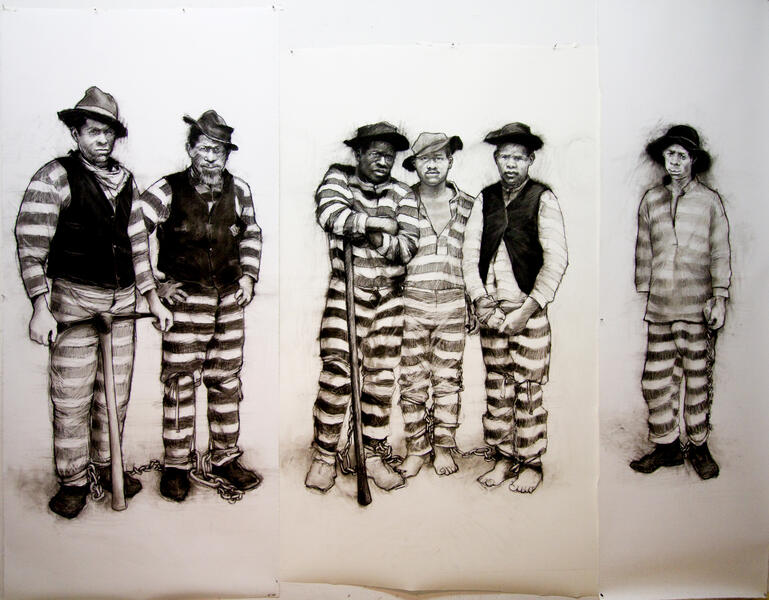 Monday Mornin' BluesThis drawing is 102” x 143”, done in charcoal and collage on separate sheets of paper which were suspended using steel rods and C-clamps. It is based on three photographs taken in Georgia and North Carolina in the 1880's and '90s by J.J. Kirkbride, Carl Weis, and a third unknown photographer. These men were six of the tens of thousands of African American men who were subjected to a new form of slavery: the incarceration and servitude of innocent men that was put into practice after Reconstruction. The chains are real, taken straight from the photographs. The men are real, too. They evolved as I worked on them, as I came to understand their different personalities and see something of the lives that they had left behind. The track which they are laying, curving away into the distance, is all they will know of freedom for years to come, perhaps all they will ever know again. I developed a brief essay on the topic to accompany the installation, which can be found in the project “written word”. (Appreciation to Douglas A Blackmon for his book “Slavery by Another Name”.)
Monday Mornin' BluesThis drawing is 102” x 143”, done in charcoal and collage on separate sheets of paper which were suspended using steel rods and C-clamps. It is based on three photographs taken in Georgia and North Carolina in the 1880's and '90s by J.J. Kirkbride, Carl Weis, and a third unknown photographer. These men were six of the tens of thousands of African American men who were subjected to a new form of slavery: the incarceration and servitude of innocent men that was put into practice after Reconstruction. The chains are real, taken straight from the photographs. The men are real, too. They evolved as I worked on them, as I came to understand their different personalities and see something of the lives that they had left behind. The track which they are laying, curving away into the distance, is all they will know of freedom for years to come, perhaps all they will ever know again. I developed a brief essay on the topic to accompany the installation, which can be found in the project “written word”. (Appreciation to Douglas A Blackmon for his book “Slavery by Another Name”.)
About Nancy

Nancy Linden’s work includes painting, drawing, assemblage and installation, writing, photography, set design and acting. Her visual art is largely figurative, most often based on photographs taken during the ’30’s and ’40’s by the photographers of the Farm Security Administration. With assemblage and site-specific installation she creates environments which spill into the realm of theater to include set design and the devising and writing of theater pieces, which in turn… more
black and white work
These are large charcoal drawings; large in scale, if not always so in dimensions. Most are roughly life-size. Many incorporate tarpaper, newsprint, canvas or other media/materials. Some are made directly from a model, some based on a photograph or multiple photographs.
-
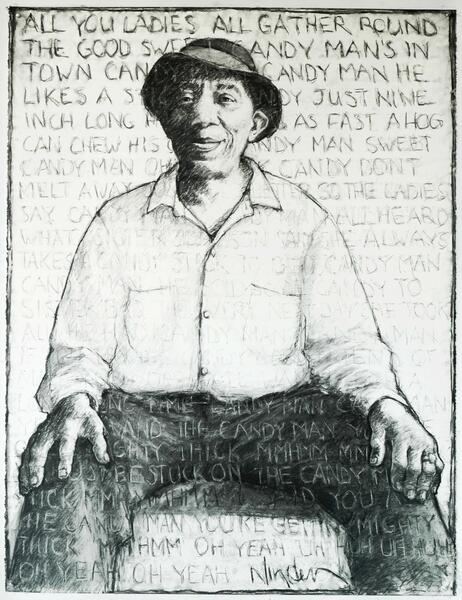 Candy Man: Mississippi John Hurt50" x 38", charcoal on paper. Mississippi John Hurt was a Delta bluesman and sharecropper from Avalon Mississippi. He made a few recordings in 1928, but they were not commercially successful. He stopped playing for the most part and continued to sharecrop. In 1963 Dick Spottswood heard those old recordings and, with Tom Hoskins, tracked him down in Avalon and brought him to Washington DC. This time he caught the folk music wave of the 1960’s and became one of the most popular and influential bluesmen of all time. He sang with sweetness, a gentle humor and sly double entendres, to his own melodious style of fingerpicking which owed more to the Piedmont blues tradition than the Delta. To this day he is revered by the best of the best. (The words in this image are the lyrics to Hurt’s Candy Man Blues, one of his sweetest--and sexiest--songs.)
Candy Man: Mississippi John Hurt50" x 38", charcoal on paper. Mississippi John Hurt was a Delta bluesman and sharecropper from Avalon Mississippi. He made a few recordings in 1928, but they were not commercially successful. He stopped playing for the most part and continued to sharecrop. In 1963 Dick Spottswood heard those old recordings and, with Tom Hoskins, tracked him down in Avalon and brought him to Washington DC. This time he caught the folk music wave of the 1960’s and became one of the most popular and influential bluesmen of all time. He sang with sweetness, a gentle humor and sly double entendres, to his own melodious style of fingerpicking which owed more to the Piedmont blues tradition than the Delta. To this day he is revered by the best of the best. (The words in this image are the lyrics to Hurt’s Candy Man Blues, one of his sweetest--and sexiest--songs.) -
timelineCharcoal and pastel on paper, tarpaper and wall. Some of the lines and head-shapes are drawn with wire. The dimensions vary with the installation, but are roughly 60" x 120". This was the title piece in an installation several years ago in which I attempted to conflate time, line and memory. The installation consisted of large charcoal drawings interconnected throughout the gallery with wire, tubing, rope, rebar and drawn line. A few other images from the installation can be seen here in the project "installations", and one of the solar etchings in “prints” was made from a photograph of this piece. “Timeline” was later reworked for the "Black Male Identity Project: Incarceration"; that version is the one included here.
-
JimiA few years ago I spoke with Woody Curry, director of The Baltimore Station, about the possibility of making drawings of the residents there. I wrongly assumed that it was a homeless shelter; Woody explained that it was a residence program for treating substance abuse, approaching treatment not only from the physical aspect but also the mental and spiritual. I don’t remember our discussion, but by the time I left his office I had volunteered to provide an art program for the men. I taught a weekly painting class there for a few years and was amazed and delighted by my students, both as individuals and as expressive artists. For my last solo show at Resurgam Gallery I hung one small room entirely with my students’ work and my drawings of them. One man, a highly skilled artist, became a particular friend, and we stayed in touch for a while; I regret that I have since lost touch with him. You can see his own work at pencilmania.net.
-
 Slow TimeCharcoal on paper, approximately 54" x 36". I made this drawing from a model, who was not a prisoner but a friend. My friend died in December 2019, just prior to Covid, or maybe one of its first victims. The drawing no longer exists, as such; I continued to work on it until it had lost something. One of the hardest parts of this is knowing when to stop.
Slow TimeCharcoal on paper, approximately 54" x 36". I made this drawing from a model, who was not a prisoner but a friend. My friend died in December 2019, just prior to Covid, or maybe one of its first victims. The drawing no longer exists, as such; I continued to work on it until it had lost something. One of the hardest parts of this is knowing when to stop. -
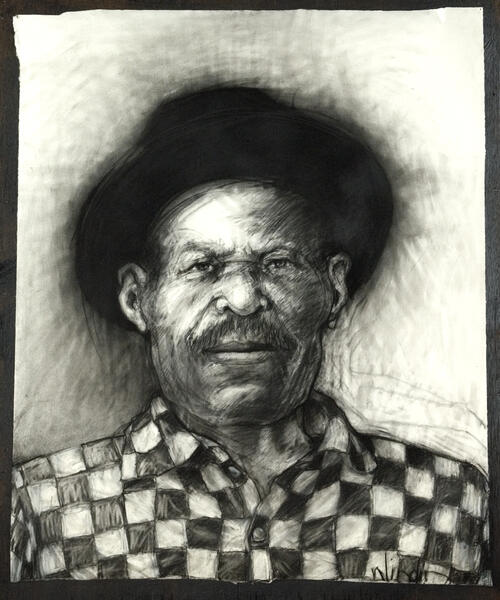 Been Born Quite a WhileCharcoal on paper, approximately 32" x 24". This drawing was based on a photograph of a farmer/musician who played in a brass band in Hale County Alabama. The title is taken from the book "Been Here and Gone" by Frederic Ramsey; he quoted Stormy Williams, trombonist in a small country band: "I've been born quite a while, but I'm here yet."
Been Born Quite a WhileCharcoal on paper, approximately 32" x 24". This drawing was based on a photograph of a farmer/musician who played in a brass band in Hale County Alabama. The title is taken from the book "Been Here and Gone" by Frederic Ramsey; he quoted Stormy Williams, trombonist in a small country band: "I've been born quite a while, but I'm here yet." -
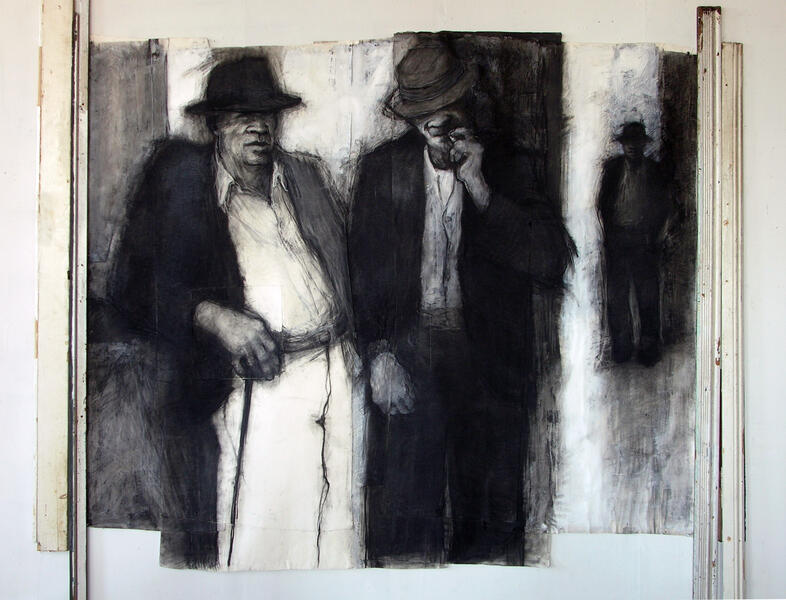 where the Southern cross the DogApproximately 74” x 86", done in charcoal, gesso, and pastel on paper. These gentlemen recur in my work with some frequency. They are based on two photographs from the Farm Security Administration. During the 1930’s and ‘40’s the FSA sent photographers the caliber of Walker Evans, Dorothea Lange and Russell Lee across the country to document rural poverty, resulting in an enormous stockpile of brilliant photographs which are in the public domain; much of my work is based on these images. I first used these particular men in an assemblage which was the basis for my installation “where the Southern cross the Dog”; that piece can be seen here in my project entitled “installations”. A few years later I made this charcoal drawing. I installed it in various manners, usually combining it with wood, as it is here; occasionally I paired it with a second figurative drawing. When I worked on a project of solar etching I used transparencies of this drawing, among others, to prepare the plates; the resultant prints can be seen in the project “prints”.
where the Southern cross the DogApproximately 74” x 86", done in charcoal, gesso, and pastel on paper. These gentlemen recur in my work with some frequency. They are based on two photographs from the Farm Security Administration. During the 1930’s and ‘40’s the FSA sent photographers the caliber of Walker Evans, Dorothea Lange and Russell Lee across the country to document rural poverty, resulting in an enormous stockpile of brilliant photographs which are in the public domain; much of my work is based on these images. I first used these particular men in an assemblage which was the basis for my installation “where the Southern cross the Dog”; that piece can be seen here in my project entitled “installations”. A few years later I made this charcoal drawing. I installed it in various manners, usually combining it with wood, as it is here; occasionally I paired it with a second figurative drawing. When I worked on a project of solar etching I used transparencies of this drawing, among others, to prepare the plates; the resultant prints can be seen in the project “prints”. -
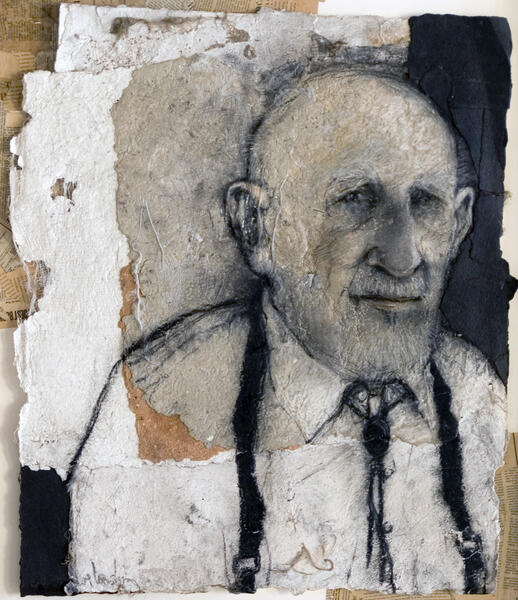 End of DayThis drawing is 34" x 29", done in charcoal and pastel on handmade paper which I made in my studio by rather primitive methods and combined with cheesecloth. It's great rough textural stuff and hell to draw on. A wonderful local model posed for it, a sweet elderly man who dressed in green-and-yellow plaid and fancied himself a borscht-belt comedian; he was fond of saying "remember, this is a nose, not a banana."
End of DayThis drawing is 34" x 29", done in charcoal and pastel on handmade paper which I made in my studio by rather primitive methods and combined with cheesecloth. It's great rough textural stuff and hell to draw on. A wonderful local model posed for it, a sweet elderly man who dressed in green-and-yellow plaid and fancied himself a borscht-belt comedian; he was fond of saying "remember, this is a nose, not a banana." -
 Monday Mornin' BluesThis drawing is 102” x 143”, done in charcoal and collage on separate sheets of paper which were suspended using steel rods and C-clamps. It is based on three photographs taken in Georgia and North Carolina in the 1880's and '90s by J.J. Kirkbride, Carl Weis, and a third unknown photographer. These men were six of the tens of thousands of African American men who were subjected to a new form of slavery: the incarceration and servitude of innocent men that was put into practice after Reconstruction. The chains are real, taken straight from the photographs. The men are real, too. They evolved as I worked on them, as I came to understand their different personalities and see something of the lives that they had left behind. The track which they are laying, curving away into the distance, is all they will know of freedom for years to come, perhaps all they will ever know again. I developed a brief essay on the topic to accompany the installation, which can be found in the project “written word”. (Appreciation to Douglas A Blackmon for his book “Slavery by Another Name”.)
Monday Mornin' BluesThis drawing is 102” x 143”, done in charcoal and collage on separate sheets of paper which were suspended using steel rods and C-clamps. It is based on three photographs taken in Georgia and North Carolina in the 1880's and '90s by J.J. Kirkbride, Carl Weis, and a third unknown photographer. These men were six of the tens of thousands of African American men who were subjected to a new form of slavery: the incarceration and servitude of innocent men that was put into practice after Reconstruction. The chains are real, taken straight from the photographs. The men are real, too. They evolved as I worked on them, as I came to understand their different personalities and see something of the lives that they had left behind. The track which they are laying, curving away into the distance, is all they will know of freedom for years to come, perhaps all they will ever know again. I developed a brief essay on the topic to accompany the installation, which can be found in the project “written word”. (Appreciation to Douglas A Blackmon for his book “Slavery by Another Name”.) -
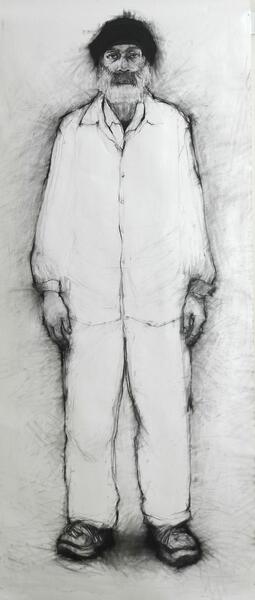 Emmanuel
EmmanuelCharcoal on paper, 102" x 42". Emmanuel was a gentle homeless man and a visionary artist who created astonishing intricately detailed architectural drawings of a world that operates somewhere outside the limitations of the usual three dimensions. We met at an exhibition of a Franciscan Center art class in which he participated; I was struck by his beauty and overcame some reticence to ask him to pose for me. We worked together for maybe six months, in my studio or the treatment center where he was sometimes confined, but he became more and more elusive; later I saw him only occasionally, when he would turn up at my door for an “advance” on his modeling fee. Eventually he disappeared altogether; perhaps, I sometimes fancied, into that other-dimensional world he had depicted.
He was also my model for "Content, Better, Best" in this project.
-
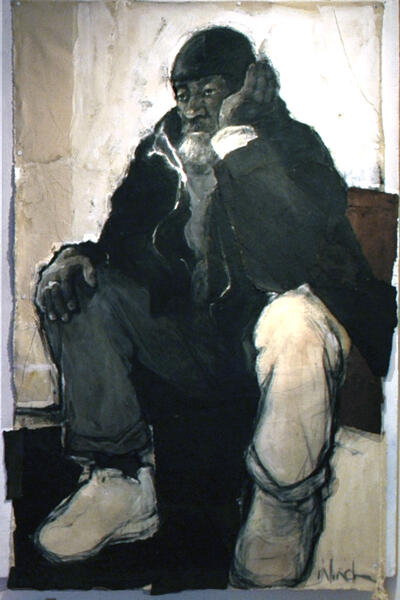 content better best
content better bestCharcoal and gesso on paper, approximately 48" x 32". Emmanuel was a gentle homeless man who posed for me for about 6 months. Please see the text under the piece entitled "Emmanuel", in this same project, for more about Emmanuel and his own art. Emmanuel named this piece.
women in black and other ladies
My first solo show consisted of paintings of solitary men and women, without a narrative. I called it “Waiting for Godeau” and accompanied it with this statement, which can be applied to these more recent women as well:
There's an acting exercise in which each actor, in however small a role, reinterprets the play in the light of his or her own character and takes the lead. These may be minor characters in minor dramas, but here they are the stars.
They are presented outside of time and context, while they were waiting for something else: for a bus, or a lover, or for the day to pass, or for news. For the time when they will light another cigarette. Something has happened here, or something is about to happen, but now they only sit and wait.
(Robert Godeau was a funeral director in San Francisco when I was in school there. I used to pass his sign every day on the bus. I’ve waited 30 years to make this pun.)
-
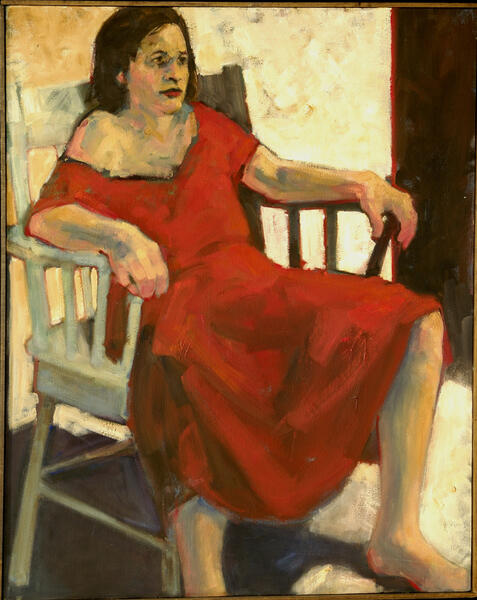 ConciergeThese women were painted for the joy of working with the lush color and textures of the oil paint. Each began with a model; each altered as I worked and began to see more deeply into the world of the painting. ~ This piece is oil on canvas, 30" x 24".
ConciergeThese women were painted for the joy of working with the lush color and textures of the oil paint. Each began with a model; each altered as I worked and began to see more deeply into the world of the painting. ~ This piece is oil on canvas, 30" x 24". -
 Lady in the Darkoil on canvas, 52" x 44"
Lady in the Darkoil on canvas, 52" x 44" -
Golden Girloil on canvas, 40" x 30"
-
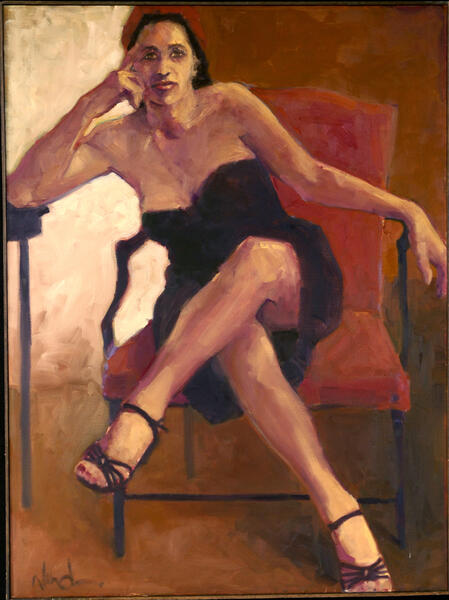 Diamonds and Rustoil on canvas, 40" x 30"
Diamonds and Rustoil on canvas, 40" x 30" -
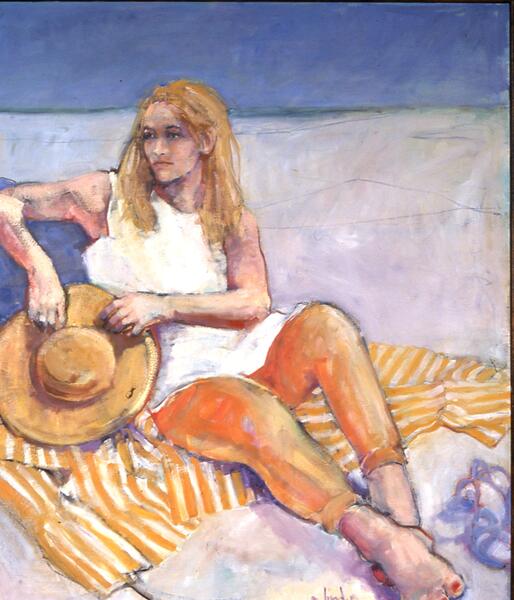 Girl on the Beach
Girl on the BeachThis young girl posed in my studio, but soon enough transposed herself to a beach. The painting is oil on canvas, 48" x 42",
-
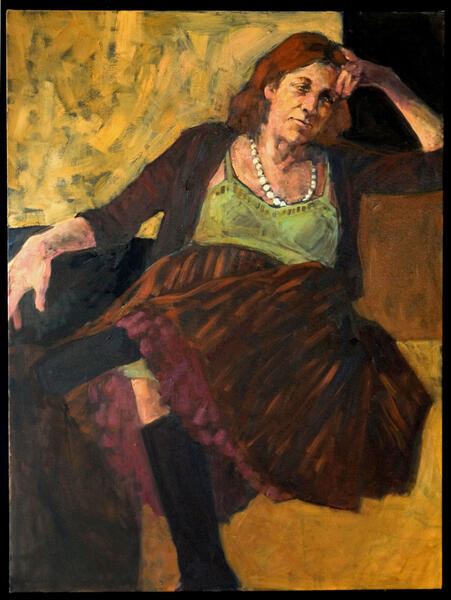 Indian Summeroil on canvas, 40" x 30"
Indian Summeroil on canvas, 40" x 30" -
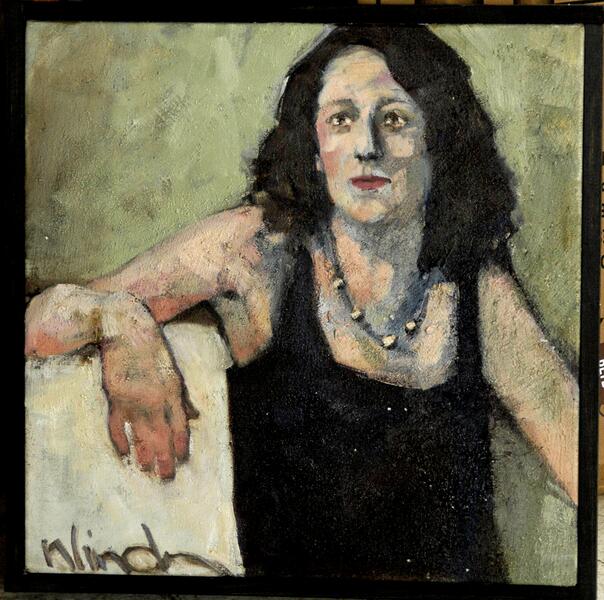 White Nightsoil and sand on canvas, 16" x 16"
White Nightsoil and sand on canvas, 16" x 16" -
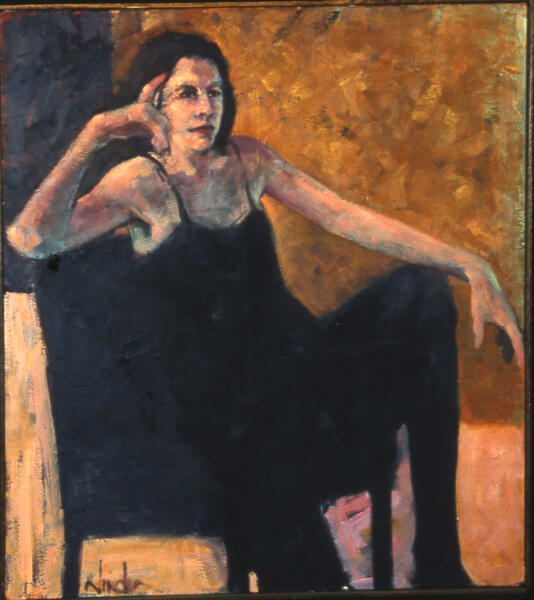 In a Gold Roomoil and encaustic on canvas, 29" x 26"
In a Gold Roomoil and encaustic on canvas, 29" x 26" -
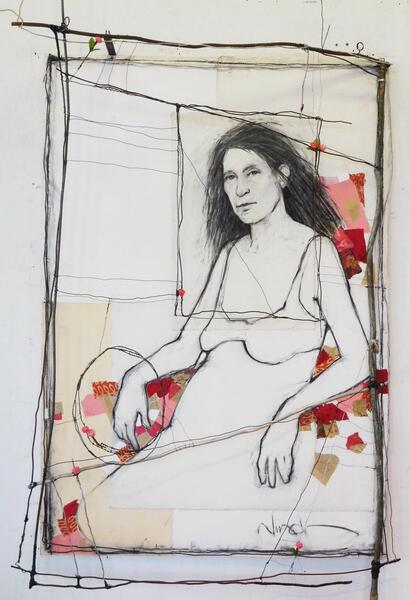 Mae Rose Cottage74" x 38" overall; the area shown is approximately 60" x 38". The underlay is charcoal and paper on Luan, with wire; the overlay is metal rod, wire and artificial flowers. The right edge of the wire overlay is hinged along the right side of the Luan; its left edge is suspended 8" in front, so it rests open like a book.
Mae Rose Cottage74" x 38" overall; the area shown is approximately 60" x 38". The underlay is charcoal and paper on Luan, with wire; the overlay is metal rod, wire and artificial flowers. The right edge of the wire overlay is hinged along the right side of the Luan; its left edge is suspended 8" in front, so it rests open like a book. -
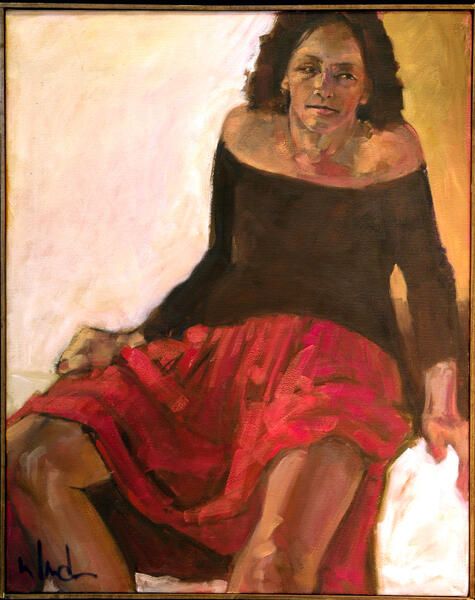 Carmen Jonesoil on canvas, 30" x 24"
Carmen Jonesoil on canvas, 30" x 24"
Gristmill
This project was created for a show in Manor Mill, an old gristmill converted to an art gallery. I fell in love with the cellar: dark and ancient and secret, a succession of old stone arches opening on rooms each darker than the last. Massive gears, turned by the millwheel in a series of gears and shafts, which conveyed grain and flour up and down through the tall building for processing. And then, beyond the final arch, the river which started it all, now underground, runs on into the dark...
Where Alph, the sacred river, ran
Through caverns measureless to man
Down to a sunless sea.
--Samuel Coleridge
Most of these pieces are rendered on drafting film, a lightly-toothed transparent film that takes charcoal beautifully and erases it just as beautifully. The figures, when there are figures, are actual historical millworkers; I have identified them when I could.
-
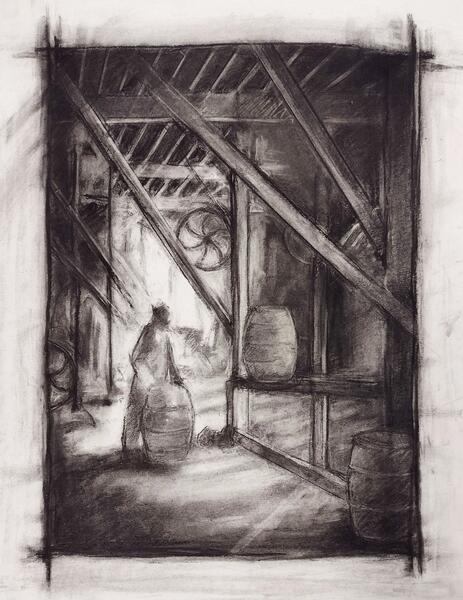 Mills Were Dark Places
Mills Were Dark Placescharcoal on paper, 20" x 14". Based on a photograph of Washburn "A" Mill, Minneapolis MN, a city with a surprising number of old flour mills.
Available for Purchase -
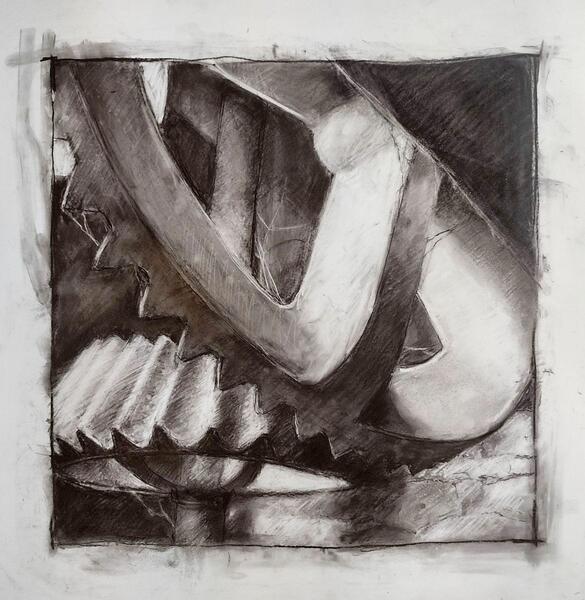 Gears Two
Gears Twocharcoal and eraser on drafting film, 16" x 16"
Available for Purchase -
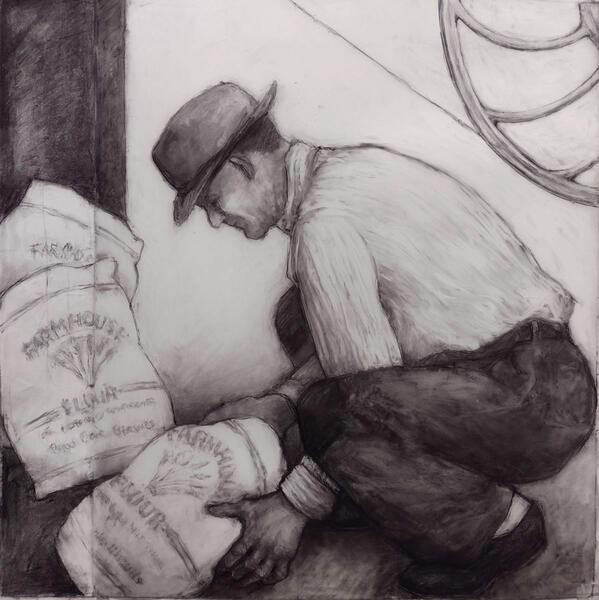 Farmhouse Flour
Farmhouse Flourcharcoal and eraser on drafting film, 36" x 36". From a 1938 photograph.
Available for Purchase -
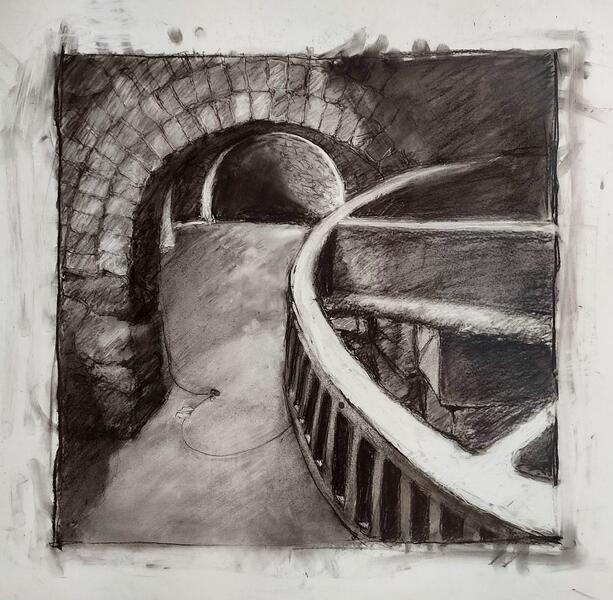 The Last Arch
The Last Archcharcoal and eraser on drafting film, 16" x 16". Beyond the final arch the millstream continues on into the dark.
Available for Purchase -
 The Cellar
The Cellarcharcoal and eraser on drafting film, 16" x 16". Entering the cellar.
Available for Purchase -
 Study for Farmhouse Flour
Study for Farmhouse Flourcharcoal and eraser on drafting film, 12" x 12". This was done as a study and proof of concept for Farmhouse Flour, above, and was my first attempt to mount the drafting film on a firm support.
Available for Purchase -
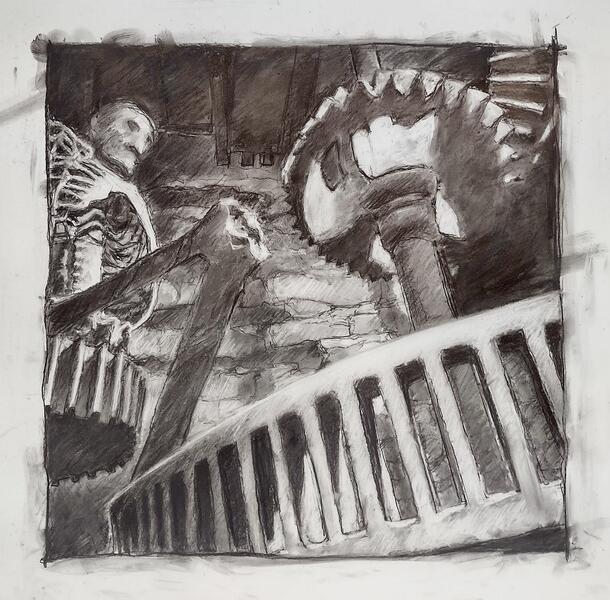 Bones
Bonescharcoal and eraser on drafting film, 16" x 16". (Well, it was Halloween.)
Available for Purchase -
 Gears One
Gears Onecharcoal and eraser on drafting film, 16" x 16".
Available for Purchase
bluesmen and other ghosts
The paintings are oil and charcoal and collage on canvas or masonite. The subjects are displaced persons, time travelers, ghosts: most of them from the 30?s and 40?s, people sidelined on farms or city streets, as represented in Farm Security Administration photographs. Apart from me, outside the flow of daily life, strong and bleak and solitary, they wake me with the rawness of their lives. The process is excavation: trying shapes and colors and removing them again, digging for bone with paint and charcoal until, as my eyes become accustomed to a different light, I begin to recognize the depths and artifacts of a certain room, a landscape, the structure of a morning, the sharp solitude of twilight; to see the colors and shadows of a world I cannot enter.
(In much the same spirit I peer sideways into lighted windows as I pass at night.)
-
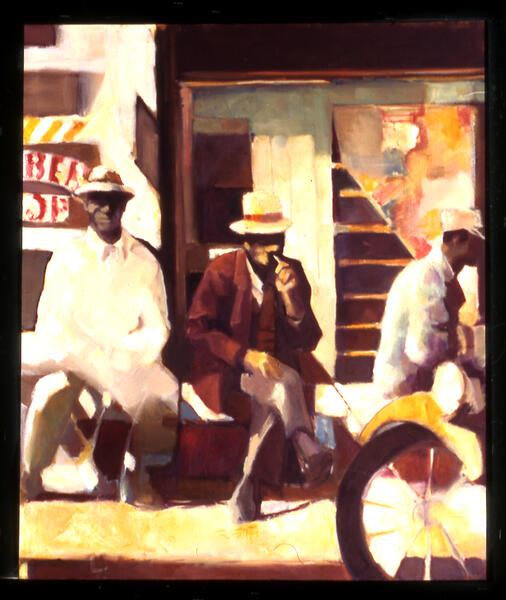 A Street in VicksburgOil on canvas, approximately 42" x 36". Vicksburg Mississippi, 1936. This is from a photograph by Walker Evans for the Farm Security Administration.
A Street in VicksburgOil on canvas, approximately 42" x 36". Vicksburg Mississippi, 1936. This is from a photograph by Walker Evans for the Farm Security Administration. -
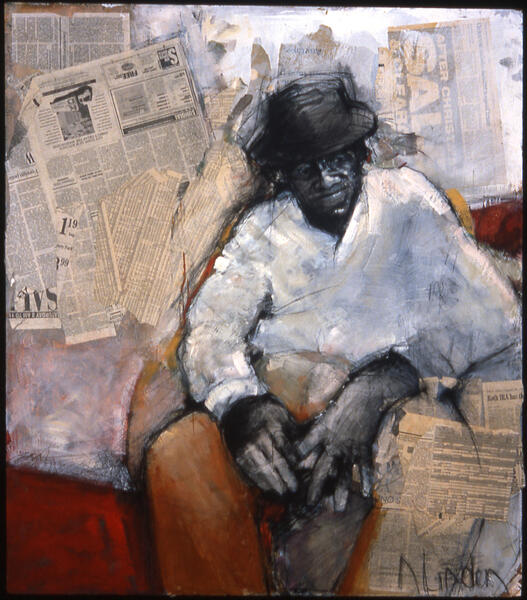 Rooms by the Week48" x 42", charcoal, oil paint, gesso and collage on masonite. Based on an FSA photograph. I have used that same seated man in other work; here he can be seen under the same title in the project “prints”. (This piece was one of three paintings rented to Runaway Bride; it can be seen, out of focus, throughout a scene in the newspaper office; it comes into focus for one split second: pow: and it’s gone.)
Rooms by the Week48" x 42", charcoal, oil paint, gesso and collage on masonite. Based on an FSA photograph. I have used that same seated man in other work; here he can be seen under the same title in the project “prints”. (This piece was one of three paintings rented to Runaway Bride; it can be seen, out of focus, throughout a scene in the newspaper office; it comes into focus for one split second: pow: and it’s gone.) -
 Sunday Afternoon"Sunday Afternoon". This painting is 54" x 42", oil and charcoal on canvas; it's based on a photograph Jack Delano took for the Farm Security Administration in 1941 in Heard County, Georgia. I've kept this painting in my personal collection; it makes me happy to look at these people.
Sunday Afternoon"Sunday Afternoon". This painting is 54" x 42", oil and charcoal on canvas; it's based on a photograph Jack Delano took for the Farm Security Administration in 1941 in Heard County, Georgia. I've kept this painting in my personal collection; it makes me happy to look at these people. -
 A Well-Spent Life40” x 30”, oil on canvas with sand. This piece was based on a photograph of the Texas bluesman Mance Lipscomb. He took the name “Mance” from “Emancipation”; his father had once been a slave.
A Well-Spent Life40” x 30”, oil on canvas with sand. This piece was based on a photograph of the Texas bluesman Mance Lipscomb. He took the name “Mance” from “Emancipation”; his father had once been a slave. -
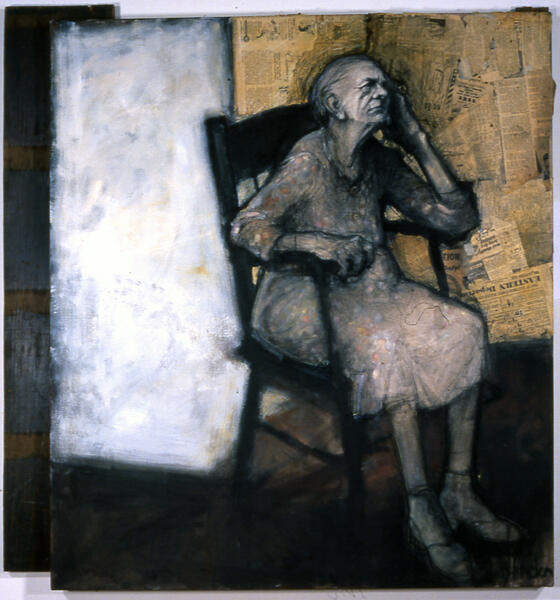 All the voices you have heard at all the kitchen tables
All the voices you have heard at all the kitchen tablesThis mixed-media piece is based on two Farm Security Administration photographs of elderly women and a poem, which I am quoting in the title. The poem can be read in the animation "Once It Was This", which can be found among the four "Work Samples" at the top of my portfolio. It measures 59” x 66”, charcoal, pastel, and oil on canvas and wood.
-
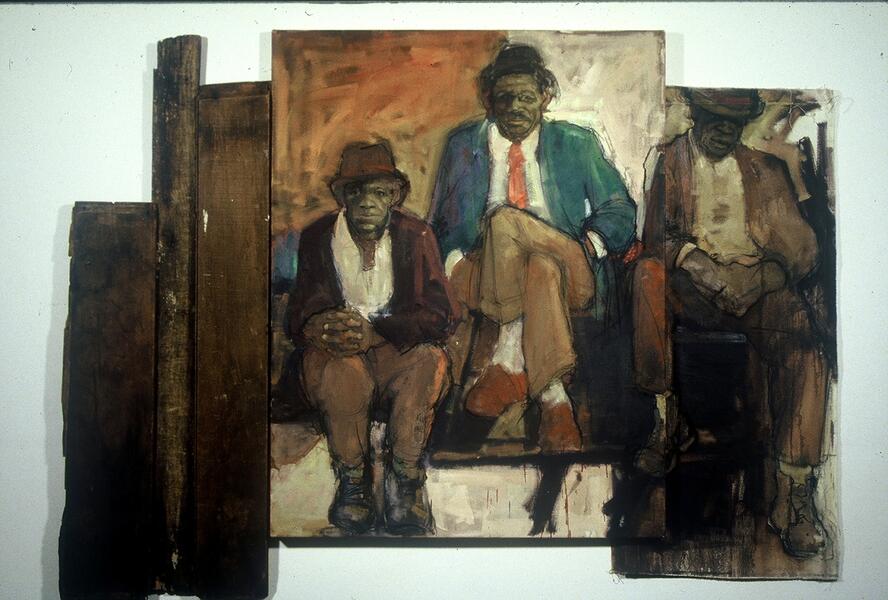 Beale Street61” x 83”, oil and charcoal on canvas with wood. This was the first large assemblage I made. It was an instinctual process: I played with materials until it seemed that the piece had assumed its necessary shape. The two central men were based on photographs of the Delta bluesmen Mississippi John Hurt and Son House. I have relocated them in Memphis, where Beale Street was a historic center for the blues.
Beale Street61” x 83”, oil and charcoal on canvas with wood. This was the first large assemblage I made. It was an instinctual process: I played with materials until it seemed that the piece had assumed its necessary shape. The two central men were based on photographs of the Delta bluesmen Mississippi John Hurt and Son House. I have relocated them in Memphis, where Beale Street was a historic center for the blues. -
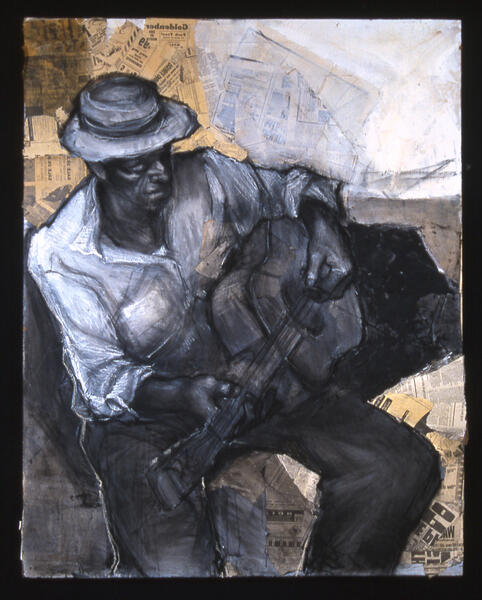 Handful of Gimme, Mouthful of Much ObligedCharcoal, pastel, newspaper and roofing tar on masonite, 48” x 38”. It is based on a photograph of Sleepy John Estes, a Tennessee blues guitarist who wrote such songs as “Drop Down Mama”, “Railroad Police Blues”, and “Rats in My Kitchen”. (He did not write “Handful of Gimme, Mouthful of Much Obliged”; Fred Neil wrote that in the ‘60’s.) Sleepy John’s epitaph, ".. ain't goin' to worry Poor John's mind anymore", was a line from his song “Someday Baby Blues”.
Handful of Gimme, Mouthful of Much ObligedCharcoal, pastel, newspaper and roofing tar on masonite, 48” x 38”. It is based on a photograph of Sleepy John Estes, a Tennessee blues guitarist who wrote such songs as “Drop Down Mama”, “Railroad Police Blues”, and “Rats in My Kitchen”. (He did not write “Handful of Gimme, Mouthful of Much Obliged”; Fred Neil wrote that in the ‘60’s.) Sleepy John’s epitaph, ".. ain't goin' to worry Poor John's mind anymore", was a line from his song “Someday Baby Blues”. -
 Entella48" x 42". As a student in San Francisco I stayed for a while in the Entella Hotel in North Beach. The single rooms there were rented by the week, and most were occupied by old Italian men, many of them crab fishermen, all of them alone. They adopted me and a friend who was also staying there, and we sat and watched them play poker into the night in the night manager's kitchen. This painting was made for them.
Entella48" x 42". As a student in San Francisco I stayed for a while in the Entella Hotel in North Beach. The single rooms there were rented by the week, and most were occupied by old Italian men, many of them crab fishermen, all of them alone. They adopted me and a friend who was also staying there, and we sat and watched them play poker into the night in the night manager's kitchen. This painting was made for them. -
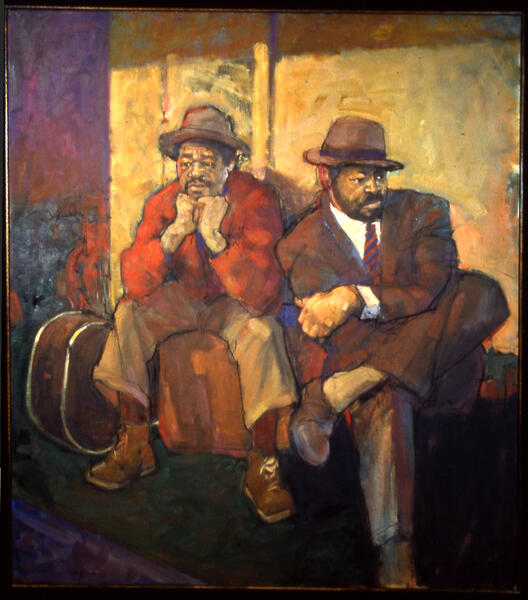 Waitin' on the Yellow DogOil on canvas, 54" x 48". The Yellow Dog was the name given to the Yazoo-Delta Railway, which ran from Moorhead to Tutweiler Mississippi. It was in Tutweiler that W.C. Handy first encountered the blues.
Waitin' on the Yellow DogOil on canvas, 54" x 48". The Yellow Dog was the name given to the Yazoo-Delta Railway, which ran from Moorhead to Tutweiler Mississippi. It was in Tutweiler that W.C. Handy first encountered the blues. -
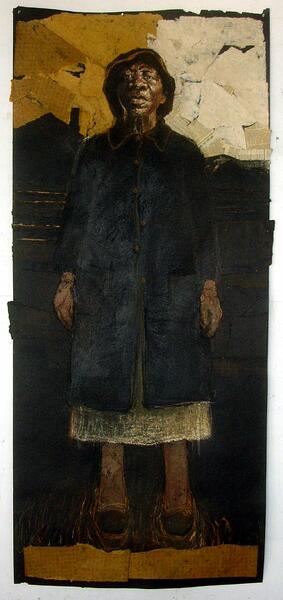 3 the home place.jpg
3 the home place.jpgA solitary woman at dusk, standing in open land; a collage of tan and cream paper and oil bar on black tarpaper. 83" x 38".
moving pictures: acting, directing and charcoal animation
For the past ten or fifteen years, my primary focus has been the theater. This project is a collection of several related activities: The first two items are shots of a set I designed for the new play "Abdication!" Next are six brief acting monologues, from "Cat on a Hot Tin Roof", "The Misanthrope", "The Little Foxes" (two delicious characters from that play), "Richard III", and "Table Manners". They are followed by a Zoom production I directed, of a 12-minute scene from the play "Everybody" by Branden Jacob Jenkins. Last is a visual interpretation of Shakespeare's Sonnet 97, using charcoal animation and still photos; I made it for a UK group which called itself The Show Must Go Online and undertook to produce Shakespeare's entire canon during lockdown, one play per week.
Also related to theater are my “Written Word” project, which includes adaptations I’ve made for the stage from other literary works, and my "Installations" project, with environments that closely approach stage design.
-
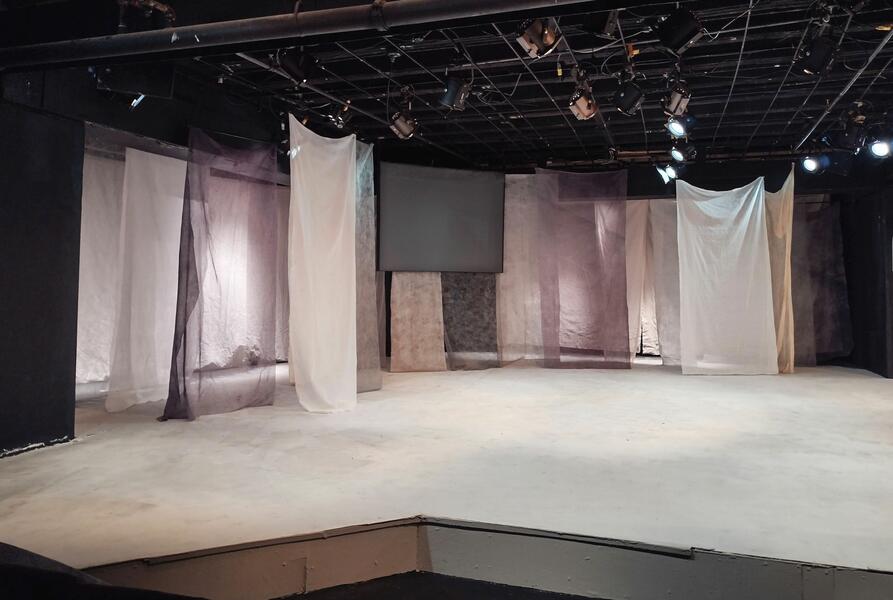 Abdication!
Abdication!This winter I designed and built a set for Abdication, a new play by Naya James, presented at Silver Spring Stage in January 2024. Abdication consists of three discrete scenes, related only by a common theme: at the end of each scene the protagonist moves into a world of unreality, fantasy, fog. A young man plans to go into suspended animation for three years and live in virtual reality. A man and a woman, each of whom has been burned by love, schedule surgery to remove the portion of their brain susceptible to romantic love; but when they meet they drop their plans and instead embark on a fantasy romance of their own. A woman tries to assert her individuality in a regimented world, and in the end is drugged and dragged offstage to have her brain altered.
I am responding to this atmosphere of uncertainty and unreality. To create the set I hung 23 panels of scrim and gauze; they move and give way as the actors move in and out of them in their passage between the real world and this dreamscape. Scrim is a material with a wide open weave. When lighted from the front, it is opaque and solid; when lighted only from behind, it becomes transparent; with some light on both sides, it is transitional, translucent. You can see layer upon layer of scrim leading back into the distance; a character will exit the stage and be lit briefly while passing behind the scrims before he disappears.
-
 "Abdication!"
"Abdication!"In this photo the front lights are dimmed on the set for "Abdication!" while the scenery is shifted. The shift is primarily lighted by the glow from light behind the scrims, which renders the fabric partially transparent. Please see the other image I've included for "Abdication!" (above) for more information.
-
Cat on a Hot Tin Roof: Big MamaA family meeting. Big Mama has just learned that Big Daddy is dying of cancer, after she had been lied to about the nature of his illness. One of her two sons is primarily concerned with getting his inheritance; the other, Brick, a difficult man whom she adores, is disgusted by the mendacity of his brother and has held himself apart from the gathering. This speech is in the final scene of the play. Cat on a Hot Tin Roof, Tennessee Williams.
-
The Misanthrope: ArsinoeThe misanthrope is Alceste, who is fed up with people and with social prevarication. He is unwillingly charmed by the beautiful young Celemene (as is every other man in sight) and is adored by Arsinoe, an unlovable Older Woman. This monologue is spoken by Arsinoe to her rival. The Misanthrope, Moliere.
-
The Little Foxes: ReginaRegina wants a life of luxury and travel and excitement, and doesn't mind hurting a few people to attain it. This may include her husband, who is ill with heart trouble. Also in this project is a monologue by Birdie, a sweet ineffectual woman who is married to one of Regina's avaricious brothers. The Little Foxes by Lillian Hellman.
-
The Little Foxes: BirdieBirdie is a sweet gentle woman who has married into a family of avaricious and powerful men--and one woman: Regina is a another of my favorite characters; I've included a monologue of hers below. In the present scene, Birdie is having cookies and a glass of elderberry wine with the three other kindhearted characters in this play. The Little Foxes, Lillian Hellman.
-
Duchess of York, from Richard III
The Duchess of York was Richard's mother. She speaks to him as he prepares to go to war.
-
Table Manners: RuthThis is Ruth from Table Manners, one of three plays by Alan Ayckbourn known collectively as The Norman Conquests after Norman, a sweet mindless doofus who manages to seduce his wife and each of her sisters.
-
EverybodyI recently directed a scene from Everybody, Branden Jacobs-Jennings' very contemporary adaptation of the Medieval morality play, Everyman. This is nearly the first scene of the play and should be self-explanatory. My actors are, in order of appearance: Kaite Aymes, Katharine McLeod, Cecily Overman, Jojo MacDonald, Celeste Cahn, Cate D'Angelo and Benjamin Heath.
-
Sonnet 97, William Shakespeare *This is my interpretation of Shakespeare's Sonnet 97, illustrated with images and animated drawings. It was made for a group based in UK, The Show Must Go Online, which produced all of Shakespeare's plays in chronological order, one each week, during lockdown.
small figures: bluesmen, farmers, ghosts
These are small assemblages which combine charcoal or wire drawings of bluesmen and farmers with found objects and materials such as wood, plaster, wire, wax, and paint. Some of them verge on the sculptural; I think of them as 2-1/2 dimensional. I find a joyous physicality in playing with the rough materials, and hope these pieces express that pleasure.
-
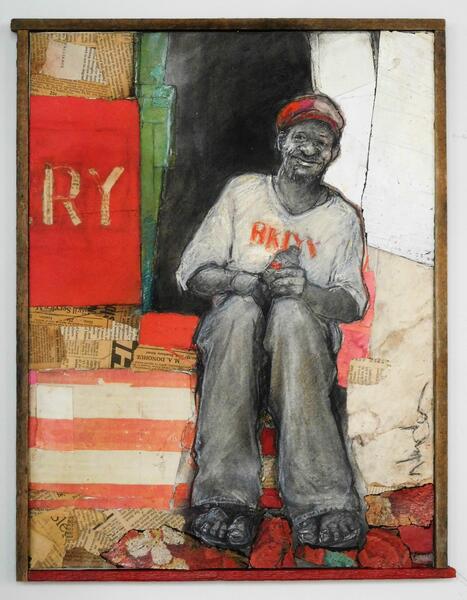 Lower Woburn Grenada--BKLYN.jpgI encountered this happy fellow on a walk-about in Grenada. I took several photos of him, which seemed to please him very much, as did the Eastern Caribbean dollar I gave him for the favor. We were on our boat then, on our way home from a year or so in Europe. We had intended to stop in Tobago, but a very strong current and a failed engine intended that we go to Grenada instead. It worked out well.
Lower Woburn Grenada--BKLYN.jpgI encountered this happy fellow on a walk-about in Grenada. I took several photos of him, which seemed to please him very much, as did the Eastern Caribbean dollar I gave him for the favor. We were on our boat then, on our way home from a year or so in Europe. We had intended to stop in Tobago, but a very strong current and a failed engine intended that we go to Grenada instead. It worked out well. -
 Standing Man15" x 16 1/2", metal, paper, tarpaper and charcoal on wood, with wood
Standing Man15" x 16 1/2", metal, paper, tarpaper and charcoal on wood, with wood -
 Pozos de Mineral (a street)Pozos de Mineral is a little white plaster village in central Mexico where I spent two magical days a few years ago. The power went out in the village one night; I sat in the square with the townspeople, who had brought candlelanterns and barbeques, and later walked home by starlight through streets empty of cars; the year could as easily have been 1940, or 1920, or 1820 ~~ This piece is 16" x 28"; wire, metal, wood, plaster, cloth and paint.
Pozos de Mineral (a street)Pozos de Mineral is a little white plaster village in central Mexico where I spent two magical days a few years ago. The power went out in the village one night; I sat in the square with the townspeople, who had brought candlelanterns and barbeques, and later walked home by starlight through streets empty of cars; the year could as easily have been 1940, or 1920, or 1820 ~~ This piece is 16" x 28"; wire, metal, wood, plaster, cloth and paint. -
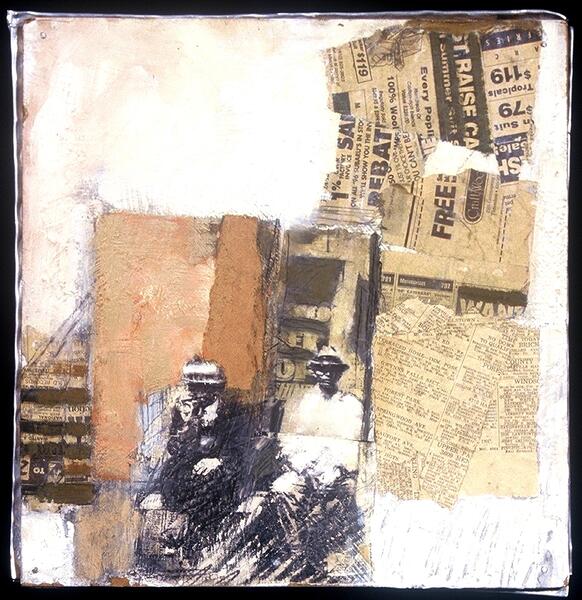 Sunday Morning12” x 12”, photo transfer, oil and newspaper on masonite. These are the same men as the two in Street Scene, the 6th piece here; I found them in a Walker Evans photograph. In this case they were transferred from a xerox with wintergreen oil.
Sunday Morning12” x 12”, photo transfer, oil and newspaper on masonite. These are the same men as the two in Street Scene, the 6th piece here; I found them in a Walker Evans photograph. In this case they were transferred from a xerox with wintergreen oil. -
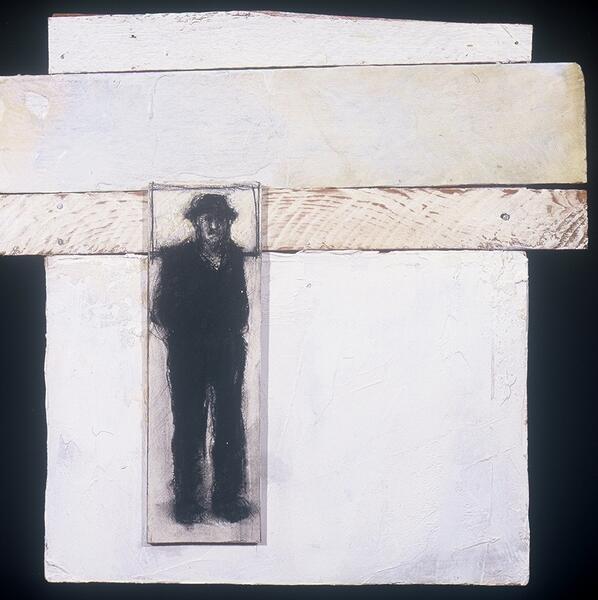 Landscape (lone figure)15" x 15 1/2", hydrocal plaster, wood, charcoal, beeswax and paint, with wood.
Landscape (lone figure)15" x 15 1/2", hydrocal plaster, wood, charcoal, beeswax and paint, with wood. -
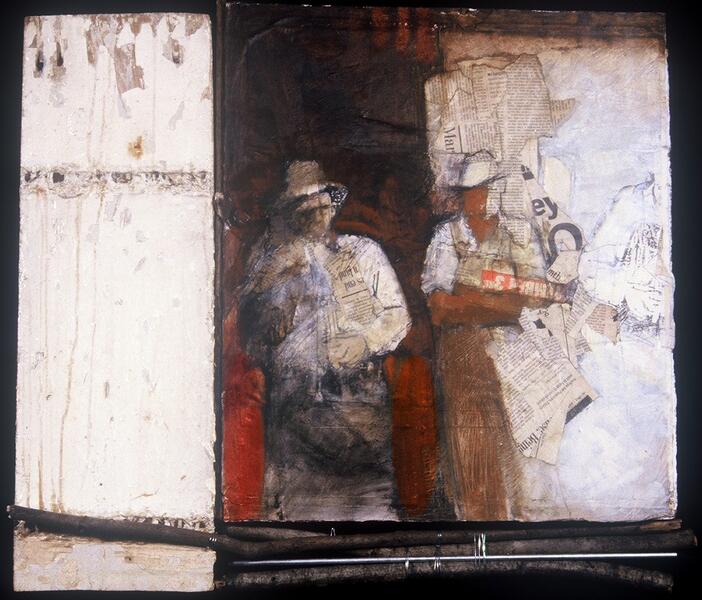 Dust Bowl Refugees25" x 27", photo transfer, oil paint and paper on masonite with wood. This was an early working of the Dorothea Lange photograph on which I based Six Tenant Farmers (see "Dust Bowl Refugees" in the projects "installations" and "written word"). Two other of the farmers can be seen here in "Tenant Farmers (sunbleached)", #8.
Dust Bowl Refugees25" x 27", photo transfer, oil paint and paper on masonite with wood. This was an early working of the Dorothea Lange photograph on which I based Six Tenant Farmers (see "Dust Bowl Refugees" in the projects "installations" and "written word"). Two other of the farmers can be seen here in "Tenant Farmers (sunbleached)", #8. -
 Landscape (steel)These small figures are farmers, bluesmen and ramblers. They are based on Farm Security Administration photos from the 1930's and '40's; some are photo transfers and some are drawings, or both. This piece is 15" x 17", metal, wire, wood, charcoal, beeswax and housepaint.
Landscape (steel)These small figures are farmers, bluesmen and ramblers. They are based on Farm Security Administration photos from the 1930's and '40's; some are photo transfers and some are drawings, or both. This piece is 15" x 17", metal, wire, wood, charcoal, beeswax and housepaint. -
 Summer Dresses
Summer Dresses -
 'Round Midnight.jpgThis collage is 14" x 18". It incorporates a print of Where the Southern cross the Dog (see in Prints project), tarpaper, silvered tarpaper, wire and wood.
'Round Midnight.jpgThis collage is 14" x 18". It incorporates a print of Where the Southern cross the Dog (see in Prints project), tarpaper, silvered tarpaper, wire and wood.
abstractions
Many of these pieces were made simply for the sensual pleasure of working with soft charcoal, thick paint and vibrant color, and a fascination with line, which I approached as if I were following it, as it moved across a page. Many of the pieces in this project, even those not obviously linear, express that fascination. Three of them were part of a larger project, which can be seen here in my projects “moving pictures” and “installations”.
-
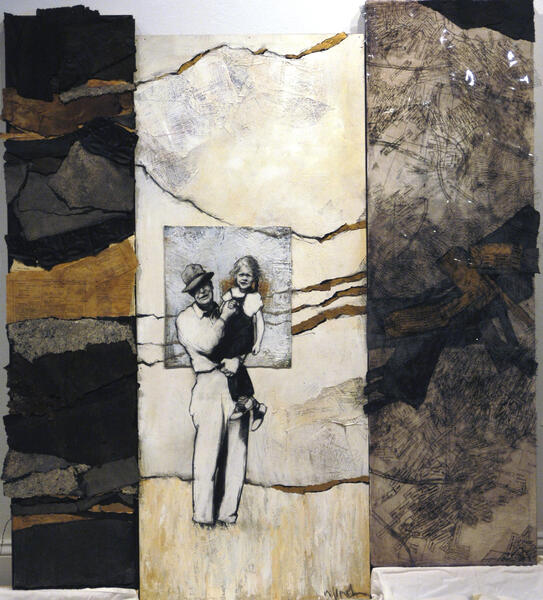 A Topology (for the Coney Island lode)I was asked to make a self-portrait for a show a few years ago, and rather than peer in a mirror I chose to work from a photograph of me at age--5? 6?--with my daddy in Colorado, where we spent my childhood summers. This piece includes collaged papers, encaustic, and transparencies of mining plats (in the panel on the right). Approximately 54" x 48". You can read the accompanying artist's statement in the project entitled "Written Word".
A Topology (for the Coney Island lode)I was asked to make a self-portrait for a show a few years ago, and rather than peer in a mirror I chose to work from a photograph of me at age--5? 6?--with my daddy in Colorado, where we spent my childhood summers. This piece includes collaged papers, encaustic, and transparencies of mining plats (in the panel on the right). Approximately 54" x 48". You can read the accompanying artist's statement in the project entitled "Written Word". -
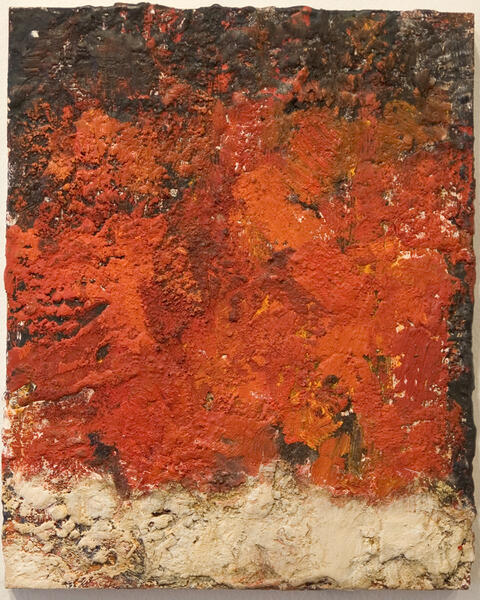 Refractions, Red Black and WhiteEncaustic on wood, 10" x 8"
Refractions, Red Black and WhiteEncaustic on wood, 10" x 8" -
 Out of MemoryThis was an out-take from my animated film, which you can see in the project “moving pictures”. The film explores time and memory; in an earlier version, a web of roots or branches (or cerebral neurons?) eventually grew over and obscured the entire image.
Out of MemoryThis was an out-take from my animated film, which you can see in the project “moving pictures”. The film explores time and memory; in an earlier version, a web of roots or branches (or cerebral neurons?) eventually grew over and obscured the entire image. -
 Refractions, Red and Greenoil on canvas
Refractions, Red and Greenoil on canvas -
 StarscapeEncaustic on wood, 10" x 8"
StarscapeEncaustic on wood, 10" x 8" -
 Wheatfieldoil on Luan, 36" x 26"
Wheatfieldoil on Luan, 36" x 26" -
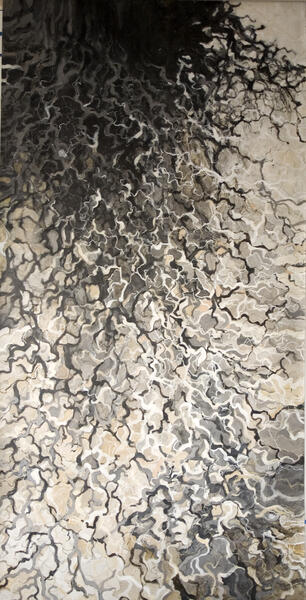 Seeking Bone150” x 78”, acrylic, oil bar, housepaint, charcoal, pastel and roofing tar on vinyl. This is a continuation of the body of work begun with my multi-media installation Timeline, exploring line, arcane theories of the structure of time, and fading memory. It represents a root system, reaching down through soil seeking the bones of the earth. It also represents a form of navigation. ~ It was originally twice this length, made as part of a project at Area 405 in which the curators hung panels of vinyl down one wall from ceiling to floor and on across the floor and invited artists to work on them. My piece was a tree, stark and broken, which rose upward as its roots reached out across the floor. I later re-worked the lower portion for a show at Maryland Art Place, and as I worked it altered; I saw the roots as moving line, blindly feeling their way down into the soil. A related essay is in the project "written word", illustrated there by a drawing of my mother and her sisters, all of whom eventually developed Alzheimer's Disease. Other pieces in that body of work include the animated film in the project “moving pictures” and Timeline in “black and white”. ~ (405 Oliver once housed a factory making window blinds and awnings. When the artists moved in, they found enormous rooms filled with rolls of vinyl and other materials. Our project barely made a dent in those stores.)
Seeking Bone150” x 78”, acrylic, oil bar, housepaint, charcoal, pastel and roofing tar on vinyl. This is a continuation of the body of work begun with my multi-media installation Timeline, exploring line, arcane theories of the structure of time, and fading memory. It represents a root system, reaching down through soil seeking the bones of the earth. It also represents a form of navigation. ~ It was originally twice this length, made as part of a project at Area 405 in which the curators hung panels of vinyl down one wall from ceiling to floor and on across the floor and invited artists to work on them. My piece was a tree, stark and broken, which rose upward as its roots reached out across the floor. I later re-worked the lower portion for a show at Maryland Art Place, and as I worked it altered; I saw the roots as moving line, blindly feeling their way down into the soil. A related essay is in the project "written word", illustrated there by a drawing of my mother and her sisters, all of whom eventually developed Alzheimer's Disease. Other pieces in that body of work include the animated film in the project “moving pictures” and Timeline in “black and white”. ~ (405 Oliver once housed a factory making window blinds and awnings. When the artists moved in, they found enormous rooms filled with rolls of vinyl and other materials. Our project barely made a dent in those stores.) -
 Refractions, Red and Greyoil and sand on canvas, 30" x 30"
Refractions, Red and Greyoil and sand on canvas, 30" x 30" -
 TreeCharcoal on various papers and wall, approximately 96" x 48". This was part of my installation "Time Line".
TreeCharcoal on various papers and wall, approximately 96" x 48". This was part of my installation "Time Line". -
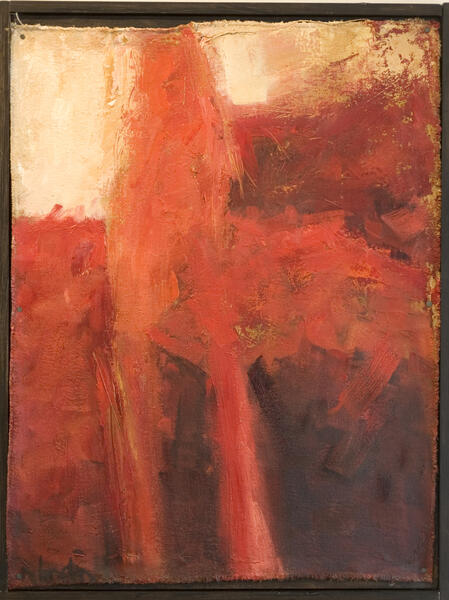 Red Figure in Landscapeoil on canvas, 24" x 18"
Red Figure in Landscapeoil on canvas, 24" x 18"
installations
I worked for many years in the theater, primarily as a set designer. It was tremendously exciting to create a piece of art which one could walk into, immerse onesself in an environment, imagine oneself in some different time and place. I still prefer to incorporate my paintings and drawings as elements of an environment, rather than to hang them individually on clean white walls. The installation "where the Southern cross the Dog" (the capitalization is deliberate; it's a line from an old blues song W.C. Handy overheard while waiting for a train) incorporated various materials and detritus which would have been part of the lives of the farmers and Delta bluesmen in my paintings. An old radio in the corner played country blues. The installation "timeline" explored expressions of time and line both in the drawings I made (mummies, trees, figures from long ago) and in the materials—wire, rope, rebar—which filled the room and passed through the air from drawing to drawing. Other of these installations were more purely abstract; one, "From Reverence to Exultation", was an actual set design for a jazz performance.
-
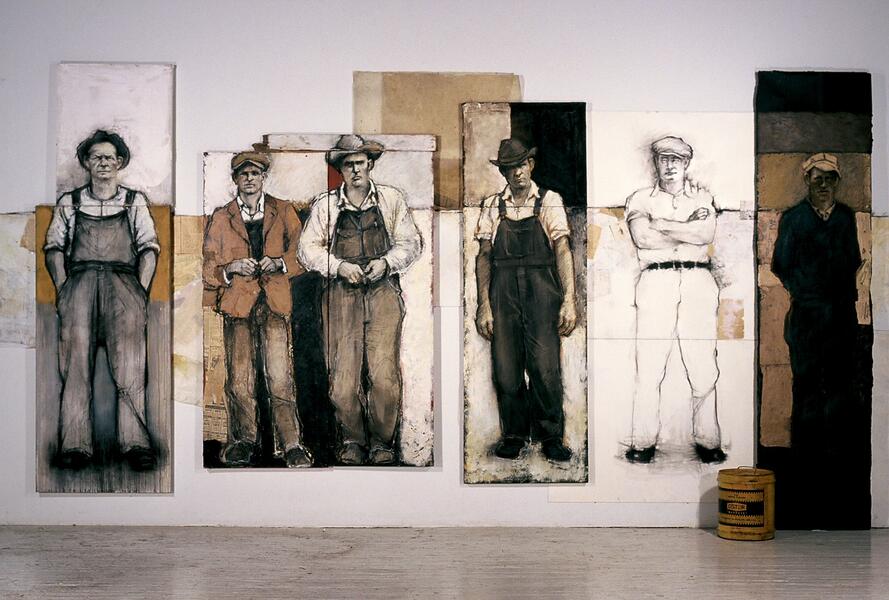 Dust Bowl RefugeesThe piece as installed is 96” x 180”; it is charcoal, pastel, gesso, oil bar, plaster, and paper collage on wood, canvas and tarpaper on the five separate panels, each panel utilizing different mediums. It is based on Dorothea Lange’s photograph of six tenant farmers who have been evicted from their land in Hardeman County, Texas, in 1937. In installation this piece was centered on one wall of the gallery; the remainder of that wall and the other three walls were left empty except for a charcoal horizon which was drawn on the wall between the men and continued around the entire room.
Dust Bowl RefugeesThe piece as installed is 96” x 180”; it is charcoal, pastel, gesso, oil bar, plaster, and paper collage on wood, canvas and tarpaper on the five separate panels, each panel utilizing different mediums. It is based on Dorothea Lange’s photograph of six tenant farmers who have been evicted from their land in Hardeman County, Texas, in 1937. In installation this piece was centered on one wall of the gallery; the remainder of that wall and the other three walls were left empty except for a charcoal horizon which was drawn on the wall between the men and continued around the entire room. -
 From Reverence to ExultationFrom Reverence to Exultation was an exhibition at the Creative Alliance in which a group of artists made work in response to John Coltrane's A Love Supreme. My part was to design, build and light a stage set for a performance by The Onus of compositions by Coltrane and Darryl Harper. I had designed sets for theater but never for a concert, so Darryl and I conferred extensively; I learned about their spatial needs, especially the square footage I must provide the drummer so that he not topple backward off his platform. Darryl agreed willingly that I might install elements that would partially obscure the musicians visually, as long as it didn’t interfere with their music; I built structures of wire, wood and metal throughout the stage and covered the walls with black-and-white drawings. ~ In the process I came to deeply admire Coltrane’s music. I had never been able to understand or enjoy it, and at first was hesitant about the project; then one evening I sat in the dark with a glass of wine and just listened, and was swept away by shattering images. I realized that this was the aural equivalent of powerful abstract painting.
From Reverence to ExultationFrom Reverence to Exultation was an exhibition at the Creative Alliance in which a group of artists made work in response to John Coltrane's A Love Supreme. My part was to design, build and light a stage set for a performance by The Onus of compositions by Coltrane and Darryl Harper. I had designed sets for theater but never for a concert, so Darryl and I conferred extensively; I learned about their spatial needs, especially the square footage I must provide the drummer so that he not topple backward off his platform. Darryl agreed willingly that I might install elements that would partially obscure the musicians visually, as long as it didn’t interfere with their music; I built structures of wire, wood and metal throughout the stage and covered the walls with black-and-white drawings. ~ In the process I came to deeply admire Coltrane’s music. I had never been able to understand or enjoy it, and at first was hesitant about the project; then one evening I sat in the dark with a glass of wine and just listened, and was swept away by shattering images. I realized that this was the aural equivalent of powerful abstract painting. -
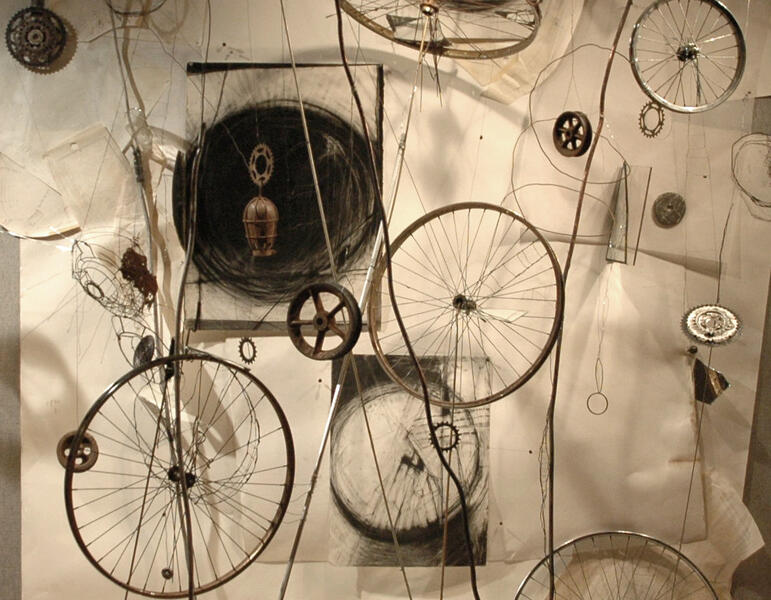 So Long and Thanks for All the Fish, detailThe area shown is approximately 48” x 60” x 24”deep, using wire, tubing, metal, bicycle parts, found objects, paper, charcoal and mirror. I made it for The Bike Project at HCC in collaboration with Breon Gilleran, a metal sculptor, who could build the structure for any fantasy. We began by playing with wheels and gears, and found distant galaxies and the harmony of the spheres.
So Long and Thanks for All the Fish, detailThe area shown is approximately 48” x 60” x 24”deep, using wire, tubing, metal, bicycle parts, found objects, paper, charcoal and mirror. I made it for The Bike Project at HCC in collaboration with Breon Gilleran, a metal sculptor, who could build the structure for any fantasy. We began by playing with wheels and gears, and found distant galaxies and the harmony of the spheres. -
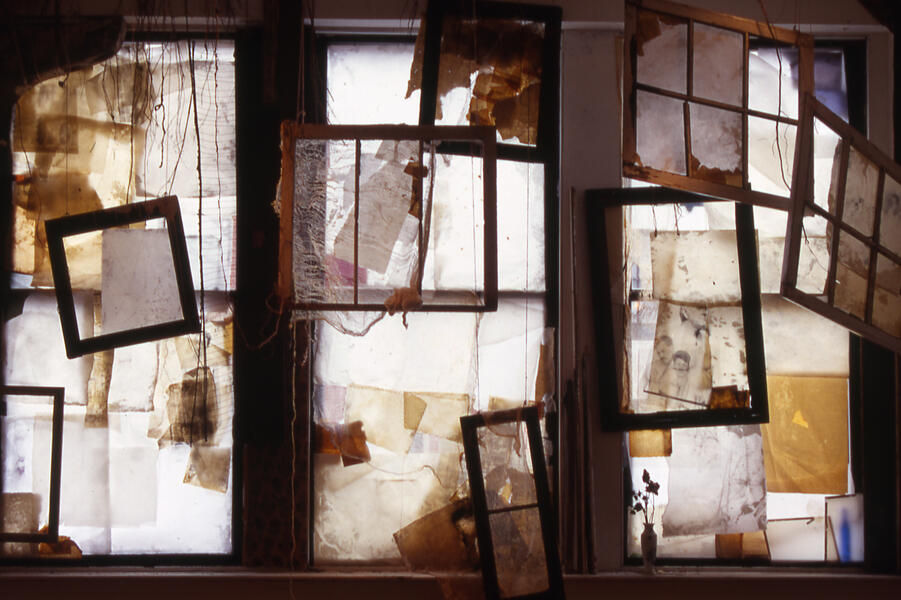 Displaced Realities: The Space BetweenNine artists took over both floors of Maryland Art Place’s original Saratoga Street gallery for two months some years ago to create a collaborative installation. We had met weekly throughout the previous summer to discuss ideas, look at one another’s work and establish parameters: we would explore unaccustomed media, interrelate our work with at least one piece of direct collaboration, and permit the others to alter our work as they might choose. During the 10-day installation period we occupied the gallery day and night, eating our meals (pizza from the shop two doors down) sitting crosslegged on the floor, leaving only to sleep. We had a big opening reception and then continued to alter the installation during the six-week run; we had a closing reception for a very different show. ~ My own work filled the window-side of the upstairs gallery. Rope, wire and tree roots reached across the room. One area became a sort of stage set, with a dim bare lightbulb suspended over an empty chair, white antique undergarments clothespinned across a window, and a 1930’s radio playing ambient sounds: the shouts of children playing, a train whistle, distant music, a woman’s laughter. I hung empty window frames in front of the actual windows and ironed beeswax into papers, book pages, drawings and cheesecloth to make a translucent window treatment. I sought to describe light diminished by time and memory; I wrote a poem which was silk screened onto the wall. This was the first of several works I’ve made concerned with the altered perceptions encountered in Alzheimer’s Disease, as I saw them in my mother.
Displaced Realities: The Space BetweenNine artists took over both floors of Maryland Art Place’s original Saratoga Street gallery for two months some years ago to create a collaborative installation. We had met weekly throughout the previous summer to discuss ideas, look at one another’s work and establish parameters: we would explore unaccustomed media, interrelate our work with at least one piece of direct collaboration, and permit the others to alter our work as they might choose. During the 10-day installation period we occupied the gallery day and night, eating our meals (pizza from the shop two doors down) sitting crosslegged on the floor, leaving only to sleep. We had a big opening reception and then continued to alter the installation during the six-week run; we had a closing reception for a very different show. ~ My own work filled the window-side of the upstairs gallery. Rope, wire and tree roots reached across the room. One area became a sort of stage set, with a dim bare lightbulb suspended over an empty chair, white antique undergarments clothespinned across a window, and a 1930’s radio playing ambient sounds: the shouts of children playing, a train whistle, distant music, a woman’s laughter. I hung empty window frames in front of the actual windows and ironed beeswax into papers, book pages, drawings and cheesecloth to make a translucent window treatment. I sought to describe light diminished by time and memory; I wrote a poem which was silk screened onto the wall. This was the first of several works I’ve made concerned with the altered perceptions encountered in Alzheimer’s Disease, as I saw them in my mother. -
 Charts for a TimeTravelerThis work was installed for Artscape. A row of 7’ x 3’ x 3’ boxes (referred to as “telephone booths”) was arrayed down Mount Royal as viewing stations. I used roots and branches, wire, glass, paper and silver leaf to draw line through space, extending it on into infinity by means of broken mirror at the top and bottom. I considered that I was mapping some arcane and crazed route, perhaps into an alternate universe.
Charts for a TimeTravelerThis work was installed for Artscape. A row of 7’ x 3’ x 3’ boxes (referred to as “telephone booths”) was arrayed down Mount Royal as viewing stations. I used roots and branches, wire, glass, paper and silver leaf to draw line through space, extending it on into infinity by means of broken mirror at the top and bottom. I considered that I was mapping some arcane and crazed route, perhaps into an alternate universe. -
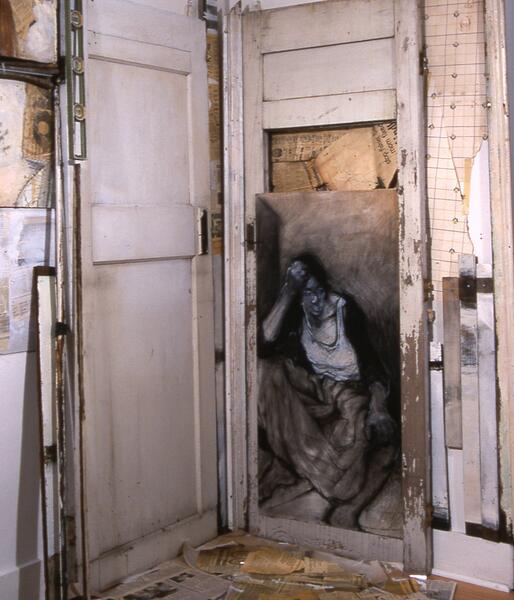 Sweet as the Showers of RainThis is a corner view of the installation “where the Southern cross the Dog”, incorporating a charcoal drawing with architectural elements, collage drawings and newspaper.
Sweet as the Showers of RainThis is a corner view of the installation “where the Southern cross the Dog”, incorporating a charcoal drawing with architectural elements, collage drawings and newspaper. -
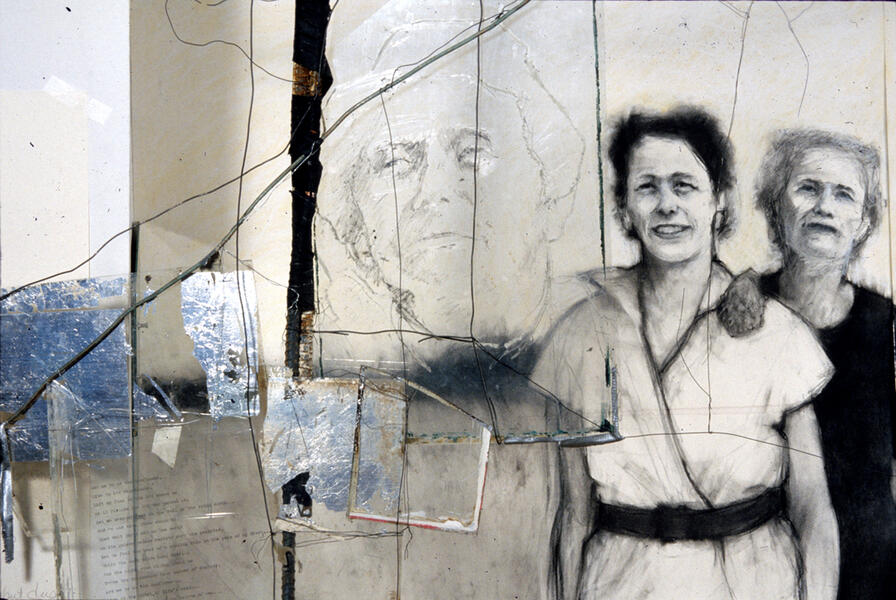 Summer DressesThis is an installation detail of "Timeline", showing the piece "Summer Dresses", a large (about 72” x 72”) charcoal drawing of my mother and four of her sisters, done from a photograph taken at a family reunion in 1957. The drawing felt too immediate, the women too easily accessed; I wanted to hold the viewer at a distance, to partially obscure the image of the women as memory fades with time. I built a structure to stand between the drawing and the viewer, using glass, wire, silver leaf, a poem and a drawing of my mother in old age. ~ Please see "Summer Dresses" in my project entitled "the written word". Also please see the video animation I made based on that drawing, in the project “moving pictures”.
Summer DressesThis is an installation detail of "Timeline", showing the piece "Summer Dresses", a large (about 72” x 72”) charcoal drawing of my mother and four of her sisters, done from a photograph taken at a family reunion in 1957. The drawing felt too immediate, the women too easily accessed; I wanted to hold the viewer at a distance, to partially obscure the image of the women as memory fades with time. I built a structure to stand between the drawing and the viewer, using glass, wire, silver leaf, a poem and a drawing of my mother in old age. ~ Please see "Summer Dresses" in my project entitled "the written word". Also please see the video animation I made based on that drawing, in the project “moving pictures”. -
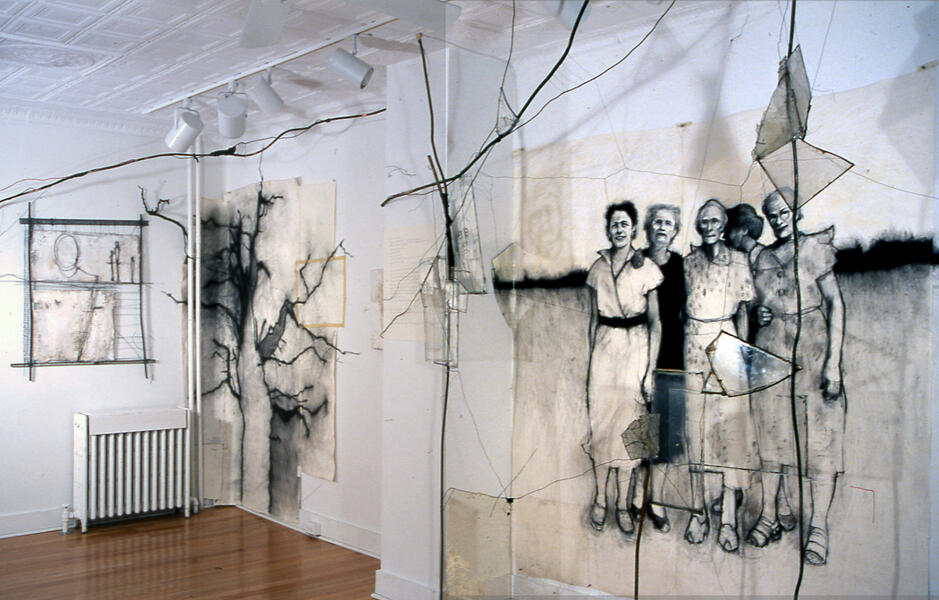 Timeline: installation viewMy installation Timeline was concerned with time, line and memory: years overlapping, line drawn in four dimensions with no beginning or end but which only enters and departs the picture. It was about drawing and being drawn, reaching like roots through soil seeking the bones of the earth. (Line: a river turns out of sight, cars pass on night highway, telephone wires catenary down a railroad track.) ~ Six large charcoal drawings were installed in the gallery unframed, and then reworked so that the charcoal line spread off the paper and across the walls (the title drawing, “Timeline”, can be seen in the project “black and white work”). I built three standing figures with wire and metal, working the wire so that it resembled my drawn line. The drawings, the figures and a few smaller pieces were interconnected with rebar and metal tubing that branched across the gallery, and irregular pieces of broken mirror placed on floor and ceiling reflected the line on into infinity.
Timeline: installation viewMy installation Timeline was concerned with time, line and memory: years overlapping, line drawn in four dimensions with no beginning or end but which only enters and departs the picture. It was about drawing and being drawn, reaching like roots through soil seeking the bones of the earth. (Line: a river turns out of sight, cars pass on night highway, telephone wires catenary down a railroad track.) ~ Six large charcoal drawings were installed in the gallery unframed, and then reworked so that the charcoal line spread off the paper and across the walls (the title drawing, “Timeline”, can be seen in the project “black and white work”). I built three standing figures with wire and metal, working the wire so that it resembled my drawn line. The drawings, the figures and a few smaller pieces were interconnected with rebar and metal tubing that branched across the gallery, and irregular pieces of broken mirror placed on floor and ceiling reflected the line on into infinity. -
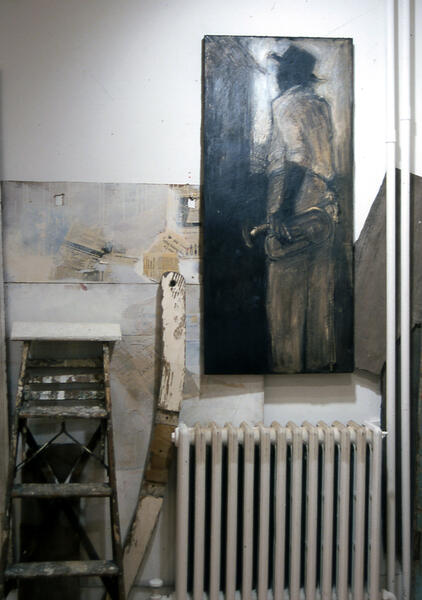 Outside the Juke-JointThis is another view of "where the Southern cross the Dog". I incorporated an old ladder in the installation, and considered that the radiator and steam pipes were part of it, too. The neighbors of the South Baltimore gallery where I installed the work were worried about me; they would peek in, see the ladder and an old can of paint which I also fancied, and say “oh dear, you still haven’t finished it!”
Outside the Juke-JointThis is another view of "where the Southern cross the Dog". I incorporated an old ladder in the installation, and considered that the radiator and steam pipes were part of it, too. The neighbors of the South Baltimore gallery where I installed the work were worried about me; they would peek in, see the ladder and an old can of paint which I also fancied, and say “oh dear, you still haven’t finished it!” -
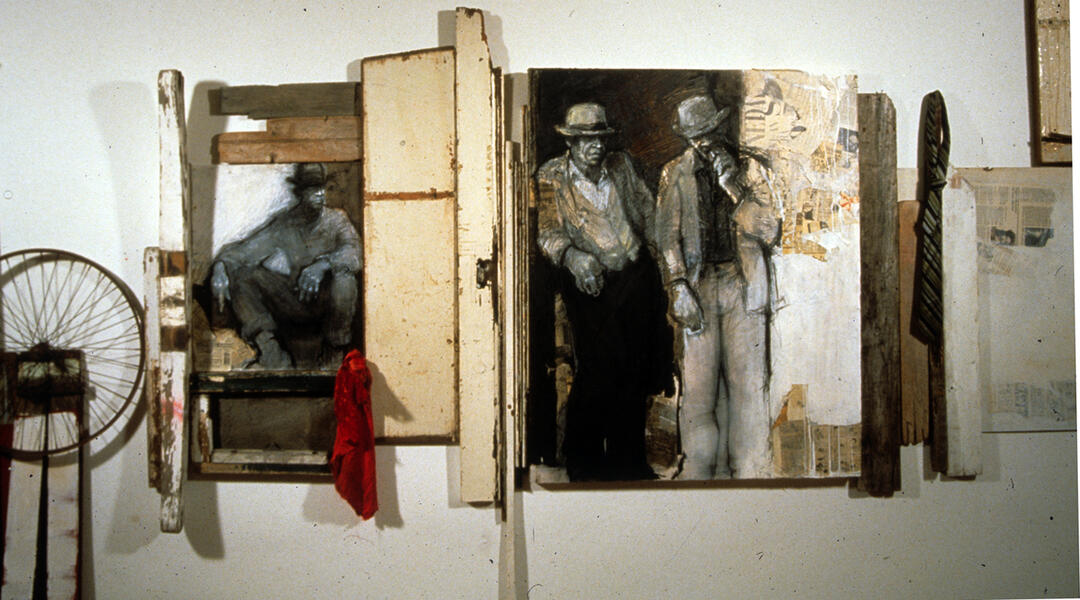 where the Southern cross the Dog“I’m goin’ where the Southern cross the Dog” is a line from an old lost railroad blues song W.C.Handy overheard while waiting for a train in a deserted station in Tutweiler Mississippi, where the Yazoo Delta Railway, known locally as the Yellow Dog, crossed the Southern. This piece was the heart of a gallery installation that combined assemblage with paintings of the sharecroppers and bluesmen of the 1930’s South.
where the Southern cross the Dog“I’m goin’ where the Southern cross the Dog” is a line from an old lost railroad blues song W.C.Handy overheard while waiting for a train in a deserted station in Tutweiler Mississippi, where the Yazoo Delta Railway, known locally as the Yellow Dog, crossed the Southern. This piece was the heart of a gallery installation that combined assemblage with paintings of the sharecroppers and bluesmen of the 1930’s South.
written word: essays, poems and theater
Sometimes a visual image doesn't seem sufficient, and I approach the work again through text or poetry or, in one case, an animated video (which can be seen at the top of my portfolio among the four "Work Samples"). The visual and written expressions can stand independently, but taken together they serve to enrich one another. Sometimes an essay may help pull together an installation or exhibition of paintings, providing insight to the viewer or, perhaps more significantly, to myself.
Other of these pieces are adaptations for the stage of a variety of works, ranging from Euripides' Trojan Women to Jack and the Beanstalk.
-
Monday Mornin' Blues…The perfect solution to both dilemmas soon became apparent: arrest and imprison black men and lease them to the railroads, the mines and the factories as a form of slave labor. While the 13th Amendment freed the slaves, it specifically permitted involuntary servitude for “duly convicted” criminals. New laws were written which targeted the freed slaves, making criminal such acts as speaking loudly in the presence of a white woman, quitting a job without permission, or “vagrancy”, which could be construed to suit one’s pleasure.
-
MoonPlayThis is a clown-play about celestial navigation. I devised and performed this piece with three actors in workshop at Single Carrot Theatre. The text as presented here is a record of what we did, together with a discussion of what we had hoped to do and how we might in future overcome some rather massive technical problems.
-
The Trojan WomenThis is a translation I am working on, based on multiple translations from the Greek. It’s a work in progress; here are two of the three scenes which I have thus far completed. For the most part I’ve used iambic pentameter, probably not what Euripides used but perhaps closer for our ears. The Messenger, however, speaks (after his first three lines) in casual contemporary prose. I have incorporated lines from TS Eliot’s The Waste Land and Sweeney Among the Nightingales. These will be read by an off-stage voice, or by a visible actor who remains outside the action.
photographs: Italy
I spent two weeks in Italy a few years ago. I missed connections and spent the first night in Toronto; my bag traveled on its own to London and Albania and reluctantly rejoined me in Siena 9 days later; I fell through a trapdoor in a shop in Rome & hurt my knee rather seriously; I had a terrific cold and stomach flu and the weather was, as we say, brutto. It was brilliant. Italy may be the most beautiful place I've ever been. I walked through so many beautiful medieval cities I became blase', thought I was beyond being surprised or impressed, and then I'd turn a corner and stop dead, mouth open, no words available save, you should pardon the expression, "holy shit". When I became thoroughly lost I'd ask directions in my rudimentary Italian and people would walk blocks out of their way, closing up shop if necessary, to take me where I wanted to go, or where they thought it sounded like I wanted to go. I took about a thousand photographs.
